Monsters
ASHEN HUSK |
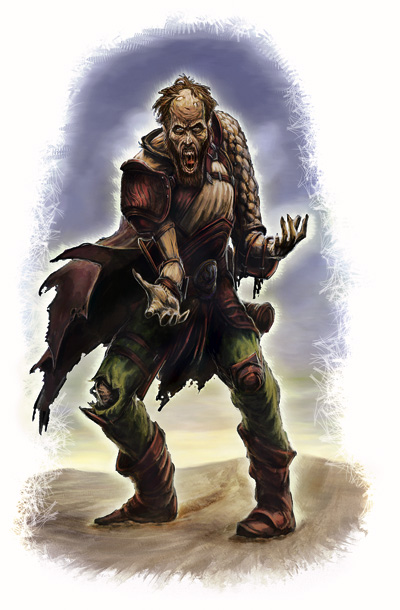 Medium Undead
Hit Dice: 2d12+7 (20 hp)
Initiative: -1
Speed: 30 ft. (6 squares; can't run)
Armor Class: 11 (-1 Dex, +2 natural), touch 9, flatfooted 11
Base Attack/Grapple: +1/+5
Attack: Slam +5 melee (ld6+6)
Full Attack: Slam +5 melee (1d6+6)
Space/Reach: 5 ft./5 ft.
Special Attacks: Create spawn, dehydrating aura
Special Qualities: Damage reduction 5/slashing, darkvision 60 ft., undead traits, unholy toughness
Saves: Fort +0, Ref -1, Will +3
Abilities: Str 18, Dex 8, Con —, Int —, Wis 10, Cha 15
Skills: —
Feats: Toughness
Environment: Any warm
Organization: Single, pair, or caravan (3-18)
Challenge Rating: 3
Treasure: None
Alignment: Always neutral evil
Advancement: 3-6 HD (Medium)
Level Adjustment: —
Medium Undead
Hit Dice: 2d12+7 (20 hp)
Initiative: -1
Speed: 30 ft. (6 squares; can't run)
Armor Class: 11 (-1 Dex, +2 natural), touch 9, flatfooted 11
Base Attack/Grapple: +1/+5
Attack: Slam +5 melee (ld6+6)
Full Attack: Slam +5 melee (1d6+6)
Space/Reach: 5 ft./5 ft.
Special Attacks: Create spawn, dehydrating aura
Special Qualities: Damage reduction 5/slashing, darkvision 60 ft., undead traits, unholy toughness
Saves: Fort +0, Ref -1, Will +3
Abilities: Str 18, Dex 8, Con —, Int —, Wis 10, Cha 15
Skills: —
Feats: Toughness
Environment: Any warm
Organization: Single, pair, or caravan (3-18)
Challenge Rating: 3
Treasure: None
Alignment: Always neutral evil
Advancement: 3-6 HD (Medium)
Level Adjustment: —
This animated corpse is bone dry, its flesh so desiccated that it appears nearly skeletal. The air around it wavers with a dry, sucking heat, as if the corpse brings with it the soul of the waterless desert.
Ashen husks lost their lives to unquenchable thirst. The evidence of their dry death is obvious as a supernatural deliquescent aura. Ashen husks stand just shy of 6 feet tall, but in their dehydrated state, weigh only about 140 pounds.
Many ashen husks died of exposure in the open desert when they became lost without water. Sometimes entire caravans go lost, and many of these unfortunate creatures might be seen years later as stumbling corpses with a thirst born in hellish heat.
COMBAT
Ashen husks slam their foes with bone-hard limbs, but they expose their real threat against living creatures caught in their dehydrating aura.
Dehydrating Aura (Su): An ashen husk gives off a 10-footradius emanation of dehydrating heat, a deadly threat for creatures that must drink to survive. A living creature within 10 feet of the ashen husk takes 1d4 points of nonlethal damage from heat each round unless it has at least heat protection level 1 (see page 14), and must make a DC 13 Fortitude save or be dehydrated (sec the dehydrated condition, page 15). A creature that makes its save gains immunity to that ashen husk's dehydrating aura ability for 24 hours, although it might still take the nonlethal damage from other sources of heat. The nonlethal damage from heat becomes lethal damage for a creature that is dehydrated. The save DC is Charisma-based.
Create Spawn (Su): Creatures killed by an ashen husk's dehydrating aura rise after 1d4 days as free-roaming ashen husks. They do not possess any of the abilities they had in life.
Unholy Toughness (Ex): An ashen husk gains a bonus to its hit points equal to its Charisma modifier times its Hit Dice (already figured).
ASHERATI |
Asherati, 1st-Level Warrior
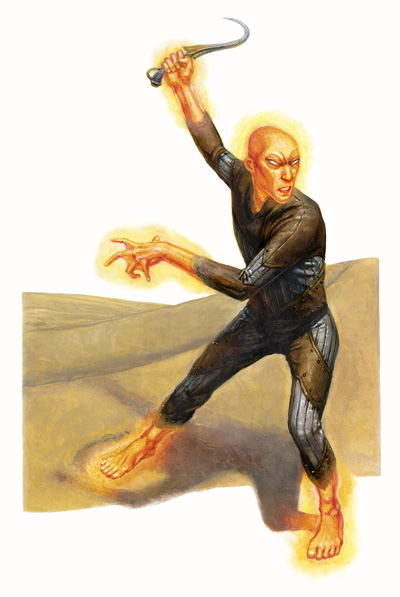 Medium Humanoid
Hit Dice: 1d8+1 (5 hp)
Initiative: +1
Speed: 30 ft. (6 squares), burrow (sand only) 30 ft.
Armor Class: 17 (+1 Dex, +2 natural armor, +3 studded leather, +1 light steel shield), touch 11, flat-footed 16
Base Attack/Grapple: +1/+2
Attack: Eagle's claw +2 melee (1d6+1/18-20)
Full Attack: Eagle's claw +0 melee (1d6+1/18-20) and eagle's claw +0 melee (1d6+1/18-20)
Space/Reach: 5 ft/5 ft.
Special Attacks: —
Special Qualities: Assherati traits, body lamp, sandswim
Saves: Fort +3, Ref +1, Will -1
Abilities: Str 13, Dex 13, Con 12, Int 8, Wis 9, Cha 8
Skills: Intimidate +3
Feats: Two-Weapon Fighting
Environment: Warm deserts
Organization: Squad (2-4) , company (11-20 plus 2 3rd-level sergeants and 1 leader of 3rd -6th level), or band (30-100 plus 100% noncombatants plus 1 3rd-level sergeant per 20 adults, 5 5th-level lieutenants, 3 7thlevel captains, 6-10 ashworms, and 2-5 riding ashworms)
Challenge Rating: 1/2
Treasure: Standard
Alignment: Usually neutral
Advancement: By character class
Level Adjustment: +0
Medium Humanoid
Hit Dice: 1d8+1 (5 hp)
Initiative: +1
Speed: 30 ft. (6 squares), burrow (sand only) 30 ft.
Armor Class: 17 (+1 Dex, +2 natural armor, +3 studded leather, +1 light steel shield), touch 11, flat-footed 16
Base Attack/Grapple: +1/+2
Attack: Eagle's claw +2 melee (1d6+1/18-20)
Full Attack: Eagle's claw +0 melee (1d6+1/18-20) and eagle's claw +0 melee (1d6+1/18-20)
Space/Reach: 5 ft/5 ft.
Special Attacks: —
Special Qualities: Assherati traits, body lamp, sandswim
Saves: Fort +3, Ref +1, Will -1
Abilities: Str 13, Dex 13, Con 12, Int 8, Wis 9, Cha 8
Skills: Intimidate +3
Feats: Two-Weapon Fighting
Environment: Warm deserts
Organization: Squad (2-4) , company (11-20 plus 2 3rd-level sergeants and 1 leader of 3rd -6th level), or band (30-100 plus 100% noncombatants plus 1 3rd-level sergeant per 20 adults, 5 5th-level lieutenants, 3 7thlevel captains, 6-10 ashworms, and 2-5 riding ashworms)
Challenge Rating: 1/2
Treasure: Standard
Alignment: Usually neutral
Advancement: By character class
Level Adjustment: +0
This humanoid's skin is a dull red, and it seems as if a light shines behind it. She has no body hair, and her eyes are ivory white. Lithe rather than thin, this creature wears tight leather armor, as if seeking to further streamline her body.
Asheratis are a geographically established people who live below the silky sands and dusts of suitable wastelands, rising to the surface to hunt for food, socialize and trade with other races, and make war upon their enemies.
Asheratis stand about 5-1/2 feet tall and usually weigh slightly more than 150 pounds. Asheratis are graceful swimmers of the dunes, and thus eschew excessive clothing or equipment, wearing only minimal, skin-hugging garments for modesty's sake. Some wear tight hide or streamlined leather armor, which does not hinder their progress through the sands.
Asheratis speak their own language and Common.
Most asheratis encountered outside their homes are warriors; the information in the statistics block is for one of 1st level.
COMBAT
Asheratis prefer to attack from ambush, hiding in the sand then rising up en masse around their foe.
Asherati Traits: Asherati traits are described in the races page.
Body Lamp (Su): An asherati can make its skin glow at will, shedding light to 60 feet and shadowy illumination to 120 feet. The light is sufficient for the asherati to navigate by while sandswimming in loose sand, dust, or ash. Once per day as a free action, an asherati can bring its skin up to full brilliance so rapidly it might dazzle creatures within 30 feet. A creature can make a DC 11 Fortitude save to negate the effect. The save DC is Charisma-based.
Sandswim (Su): Asheratis gain a burrow speed equal to their base land speed while wearing light armor or carrying a light load and traveling through sand, ash, or other loose soil. This speed drops to 5 feet with a heavier load or if an asherati tries to drag a Medium or larger crearure along. An asherati can breathe normally while sandswimming.
Skills: Asheratis have a +2 racial bonus on Move Silently and Hide checks (an asherati cannot Hide while its ski n glows). If in a sandy area, an asherati receives an additional +2 racial bonus on Hide checks. The asherati warrior presented here had the following ability scores before racial adjustments: Str 13, Dex 11, Con 12, Int 10, Wis 9, Cha 8.
ASHWORM |
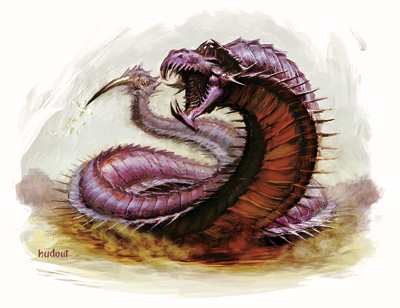 Large Magical Beast
Hit Dice: 3d10+9 (25 hp)
Initiative: +0
Speed: 30 ft. (6 squares), burrow 30 ft., climb 5 ft.
Armor Class: 14 (-1 size, +5 natural), touch 9, flatfooted 14
Base Attack/Grapple: +3/+12
Attack: Sting +7 melee (1d6+7 plus poison)
Full Attack: Sting +7 melee (1d6+7 plus poison)
Space/Reach: 10 ft./5 ft.
Special Attacks: Poison
Special Qualities: Evasive diver, tremorsense 60 ft.
Saves: Fort +4, Ref +5, Will +4
Abilities: Str 21, Dex 10, Con 17, Int 1, Wis 13, Cha 6
Skills: Climb +16, Listen +6, Spot +3
Feats: Alertness, Lightning Reflexes
Environment: Warm deserts or plains
Organization: Solitary, cluster (2-4), or herd (6-30)
Challenge Rating: 2
Treasure: None
Alignment: Always neutral
Advancement: 4-6 HD (Large); 6-9 HD (Huge)
Level Adjustment: —
Large Magical Beast
Hit Dice: 3d10+9 (25 hp)
Initiative: +0
Speed: 30 ft. (6 squares), burrow 30 ft., climb 5 ft.
Armor Class: 14 (-1 size, +5 natural), touch 9, flatfooted 14
Base Attack/Grapple: +3/+12
Attack: Sting +7 melee (1d6+7 plus poison)
Full Attack: Sting +7 melee (1d6+7 plus poison)
Space/Reach: 10 ft./5 ft.
Special Attacks: Poison
Special Qualities: Evasive diver, tremorsense 60 ft.
Saves: Fort +4, Ref +5, Will +4
Abilities: Str 21, Dex 10, Con 17, Int 1, Wis 13, Cha 6
Skills: Climb +16, Listen +6, Spot +3
Feats: Alertness, Lightning Reflexes
Environment: Warm deserts or plains
Organization: Solitary, cluster (2-4), or herd (6-30)
Challenge Rating: 2
Treasure: None
Alignment: Always neutral
Advancement: 4-6 HD (Large); 6-9 HD (Huge)
Level Adjustment: —
This large, eyeless worm is as big as a horse. It is covered in a thin chitinous layer of pale purple plates. A nasty stinger quivers at the end of its tail.
Wild ashworms are distant cousins to the purple worm, but not nearly as large or aggressive (not able to gulp down prey in a single mouthful). Traveling in vast herds both above and below the desert sands, the sound of a herd's approach is akin to thunder. As a result, ashworms are sometimes called thunderherders.
Ashworms are sometimes caught and trained as mounts, though a trainer clips off the dangerous stinger. Ashworms can be induced to travel on the sand's surface (or even packed earth or stone) exclusively by a skilled rider. However, the rider must succeed on a DC 15 Ride check once every 24 hours it in a sandy environment or be swept off the back of the ashworm as it dives below the surface for 1d4 rounds before returning to the surface. Expert riders who put up with this behavior are somewhat mollified by the ashworms ability to secrete a substance that allows it to stick to vertical surfaces; a rider securely strapped to an ashworms back can climb up walls or other impediments with his mount, albeit slowly. An ashworm is hard to control in combat (see Mounted Combat, page 157 of the Player's Handbook), unless it belongs to an ashworm dragoon (see page 66).
Carrying Capacity: A light load for an ashworm is up to 500 pounds; a medium load, up to 900 pounds; and a heavy load, up to 1,400 pounds. An ashworm can drag 6,900 pounds.
COMBAT
Ashworms hunt prey from beneath the sand, then rise to confront their targets In battle, an ashworm forms into a coil, stinging anything in reach.
Poison (Ex): Injury, Fortitude DC 14, initial and secondary damage 2d6 Str. The save DC is Constitutionbased
Evasive Diver (Ex): In areas of sand (not packed earth or stone), the ashworm feels more secure because of its evasive diver ability. If the ashworm makes a successful Reflex saving throw against an attack that normally deals half damage on a successful save, the ashworm instead manages to instantly dive below the protective sand or earth and takes no damage.
An ashworm's rider might be swept from the ashworm's back unless it makes a DC 15 Reflex save when the ashworm dives below the sand. If the rider tails this save, it is swept from the ashworm's back. Particularly skilled riders, such as ashworm dragoons with the sand rider ability, go along for the dive and also take no damage from the effect that prompted the ashworm's Reflex save.
BHUKA |
Bhuka,1st-Level Warrior
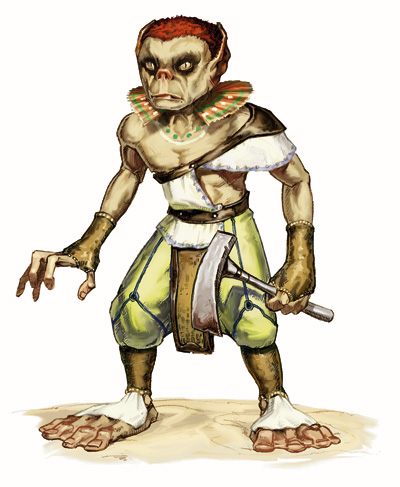 Medium Humanoid (Goblinoid)
Hit Dice: 1d8+1 (5 hp)
Initiative: +1
Speed: 30 ft. (6 squares)
Armor Class: 13 (+1 Dex, + 1 padded,+ 1 light steel shield), touch 11, flat-footed 12
Base Attack/Grapple: +1/+1
Attack: Club +1 melee (1d6) or shortbow +2 ranged (1d6/x3)
Full Attack: Club +1 melee (1d6) or shortbow +2 ranged (1d6/x3)
Space/Reach: 5 ft./5 ft.
Special Attacks: —
Special Qualities: Bhuka traits
Saves: Fort +3 (+5 against heat and dehydration), Ref +1, Will -1
Abilities: Str 11, Dex 13, Con 12, Int 10, Wis 9, Cha 8
Skills: Jump +3, Knowledge (nature) +3, Spot +0, Survival +0
Feats: Endurance
Environment: Warm deserts
Organization: Solitary, team (2-5), band (6-16 plus 1 3rd-level leader [usually ranger or druid]), or phratry (20-100 plus 1 3rd-level leader per 10 adults, 3 5th-level shamans [druids], and 1 7th-level chieftain)
Challenge Rating: 1/2
Treasure: Standard
Alignment: Usually lawful good
Advancement: By character class
Level Adjustment: +0
Medium Humanoid (Goblinoid)
Hit Dice: 1d8+1 (5 hp)
Initiative: +1
Speed: 30 ft. (6 squares)
Armor Class: 13 (+1 Dex, + 1 padded,+ 1 light steel shield), touch 11, flat-footed 12
Base Attack/Grapple: +1/+1
Attack: Club +1 melee (1d6) or shortbow +2 ranged (1d6/x3)
Full Attack: Club +1 melee (1d6) or shortbow +2 ranged (1d6/x3)
Space/Reach: 5 ft./5 ft.
Special Attacks: —
Special Qualities: Bhuka traits
Saves: Fort +3 (+5 against heat and dehydration), Ref +1, Will -1
Abilities: Str 11, Dex 13, Con 12, Int 10, Wis 9, Cha 8
Skills: Jump +3, Knowledge (nature) +3, Spot +0, Survival +0
Feats: Endurance
Environment: Warm deserts
Organization: Solitary, team (2-5), band (6-16 plus 1 3rd-level leader [usually ranger or druid]), or phratry (20-100 plus 1 3rd-level leader per 10 adults, 3 5th-level shamans [druids], and 1 7th-level chieftain)
Challenge Rating: 1/2
Treasure: Standard
Alignment: Usually lawful good
Advancement: By character class
Level Adjustment: +0
This slightly built humanoid has deep-set eyes, a flat face with slitted nostrils, and large, spreading ears. A frill of skin around its throat is daubed with paint, and its splayed feet barely sink into the sand.
Bhukas are consummate survivors, with many physical adaptations to help them thrive in the waste. They are experts at farming and finding water in the forbidding lands they call home.
Bhukas form extended families and communities bound through ritual and preservation of ancestral ways. Art and lore are central to their culture. They are gentle people, but they will fight firmly against those who attack their land and their livelihood.
A council of elders rules each bhuka settlement, headed by a Grandmother who is the spiritual leader of the community. They have trading relationships with other desert inhabitants, in particular the crucians.
Bhukas speak their own language, and many also speak Draconic to deal with crucian traders. A few learn Common or Goblin.
COMBAT
Bhuka are not warlike, preferring to remain unseen and observe newcomers from a distance to gauge their intentions. If combat is necessary, bhuka fight in loose bands and employ skirmish tactics. Usually a druid or ranger leads a fighting band and lends magical support.
Bhuka Traits: Bhuka traits are described in the races page.
The bhuka warrior presented here had the following ability scores before racial adjustments: Str 13, Dex 11, Con 12, Int 10, Wis 9, Cha 8.
CAMELOPARDEL |
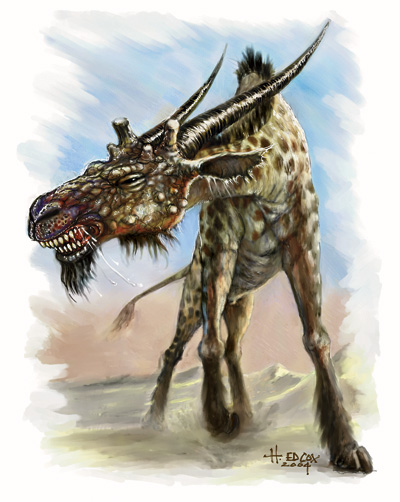 Large Magical Beast
Hit Dice: 5d10+10 (37 hp)
Initiative: +1
Speed: 50 ft. (10 squares)
Armor Class: 12 (-1 size, +1 Dex, +2 natural), touch 10, flat-footed 11
Base Attack/Grapple: +5/+12
Attack: Gore +7 melee (1d6+3)
Full Attack: Gore +7 melee (1d6+3) and 2 hooves +2 melee (1d4+1)
Space/Reach: 10 ft./5 ft. (10 ft. with gore)
Special Attacks: Haboob
Special Qualities: iesura of protection from dessication, hydrate, low-light vision, scent, wild empathy
Saves: Fort +6, Ref +5, Will +4
Abilities: Str 16, Dex 13, Con 14, Int 5, Wis 12, Cha 15
Skills: Jump +-11, Listen +7, Spot +7
Feats: Alertness, Iron Will
Environment: Warm deserts
Organization: Solitary
Challenge Rating: 3
Treasure: None
Alignment: Usually neutral good
Advancement: 6-10 HD (Large); 11-15 HD (Huge)
Level Adjustment: —
Large Magical Beast
Hit Dice: 5d10+10 (37 hp)
Initiative: +1
Speed: 50 ft. (10 squares)
Armor Class: 12 (-1 size, +1 Dex, +2 natural), touch 10, flat-footed 11
Base Attack/Grapple: +5/+12
Attack: Gore +7 melee (1d6+3)
Full Attack: Gore +7 melee (1d6+3) and 2 hooves +2 melee (1d4+1)
Space/Reach: 10 ft./5 ft. (10 ft. with gore)
Special Attacks: Haboob
Special Qualities: iesura of protection from dessication, hydrate, low-light vision, scent, wild empathy
Saves: Fort +6, Ref +5, Will +4
Abilities: Str 16, Dex 13, Con 14, Int 5, Wis 12, Cha 15
Skills: Jump +-11, Listen +7, Spot +7
Feats: Alertness, Iron Will
Environment: Warm deserts
Organization: Solitary
Challenge Rating: 3
Treasure: None
Alignment: Usually neutral good
Advancement: 6-10 HD (Large); 11-15 HD (Huge)
Level Adjustment: —
A graceful creature resembling a cross between a giraffe and a panther stands tail on long legs. It has a long neck, and two long, curving horns sweep back from its brow.
A camelopardel is a solitary being that inhabits a waste territory, browsing on its scant vegetation and protecting the smaller creatures in the area.
Camelopardels are able to resist extremes of dryness that even other desert creatures cannot, due to their innate abilities. They extend this protection to nearby friendly creatures and tend to those who are injured by harmful desert magic. These regal creatures are often represented in heraldry or desert tribes' totems. A sighting of a camelopardel in the vicinity is taken as a sign of favor from good waste deities.
A camelopardel speaks a waste dialect of Sylvan but does not usually talk.
COMBAT
A camelopardel is not a powerful combatant. It prefers to drive off intruders by making the environment unfriendly with its haboob ability. The dust cloud also serves it well for escape against enemies that are too powerful to defeat.
Haboob (Su): At will as a standard action, a camelopardel can create a haboob effect, as the spell (see page 117). Each use of the effect lasts for 5 rounds.
Aura of Protection from Dessication (Su): A camelopardel is constantly surrounded by a 10-foot-radius emanation that duplicates the effects of the protection from dessication spell (see page 119). Any creature within this radius, including the camelopardel, is protected from up to 50 points of damage from dehydration, whether magical (such as from the desiccate spell) or natural (such as from heat if the creature is dehydrated) in origin. Once the effect has absorbed the maximum amount of damage, that creature is no longer protected. If the camelopardel takes sufficient damage to lose this protection, the effect ends temporarily. It automatically renews after 10 minutes.
Hydrate (Sp): Three times per day, a camelopardel can use hydrate as a 5th-level spellcaster by gently touching a target with its tongue.
Wild Empathy (Ex): This ability works like the druid's wild empathy class feature. The camelopardels level is equal to its Hit Dice.
CHEKRYAN |
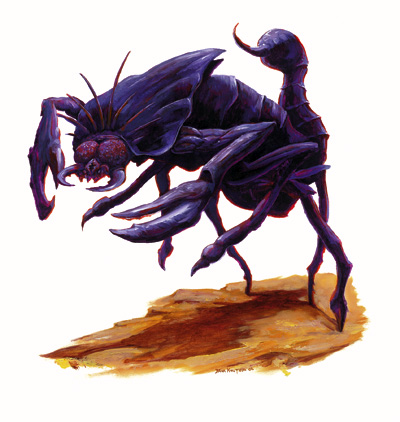 Large Magical Beast (Psionic)
Hit Dice: 3d10+18 (34 hp)
Initiative: +1
Speed: 40 ft. (6 squares), burrow 10 ft.
Armor Class: 19 (-1 size, +1 Dex, +9 natural), touch 10, flat-footed 18
Base Attack/Grapple: +3/+12
Attack: Claw +7 melee (2d6+5)
Full Attack: 2 claws +7 melee (2d6+5) and bite +5 melee (1d6+2) and sting+5 melee (1d6+2 plus poison)
Space/Reach: 10 ft./10 ft.
Special Attacks: Constrict 1d6+5, improved grab, poison, psi-like abilities
Special Qualities: Darkvision 60 ft., low-light vision, tremorsense 60 ft.
Saves: Fort +8, Ref +4, Will +2
Abilities: Str 21, Dex 12, Con 20, Int 1,Wis 13, Cha 16
Skills: Climb +8, Jump +9, Listen +6, Spot +3
Feats: Alertness, Toughness, MultiattackB
Environment: Warm deserts
Organization: Solitary or colony (2-5)
Challenge Rating: 4
Treasure: Standard
Alignment: Always neutral
Advancement: 4 HD (Large); 5-9 HD (Huge)
Level Adjustment: —
Large Magical Beast (Psionic)
Hit Dice: 3d10+18 (34 hp)
Initiative: +1
Speed: 40 ft. (6 squares), burrow 10 ft.
Armor Class: 19 (-1 size, +1 Dex, +9 natural), touch 10, flat-footed 18
Base Attack/Grapple: +3/+12
Attack: Claw +7 melee (2d6+5)
Full Attack: 2 claws +7 melee (2d6+5) and bite +5 melee (1d6+2) and sting+5 melee (1d6+2 plus poison)
Space/Reach: 10 ft./10 ft.
Special Attacks: Constrict 1d6+5, improved grab, poison, psi-like abilities
Special Qualities: Darkvision 60 ft., low-light vision, tremorsense 60 ft.
Saves: Fort +8, Ref +4, Will +2
Abilities: Str 21, Dex 12, Con 20, Int 1,Wis 13, Cha 16
Skills: Climb +8, Jump +9, Listen +6, Spot +3
Feats: Alertness, Toughness, MultiattackB
Environment: Warm deserts
Organization: Solitary or colony (2-5)
Challenge Rating: 4
Treasure: Standard
Alignment: Always neutral
Advancement: 4 HD (Large); 5-9 HD (Huge)
Level Adjustment: —
This creature shares some traits in common with a scorpion, but one that has grown to monstrous size and adopted a partially upright posture, allowing it to bite foes with its dangerous mandibles.
Chekryans were obviously engendered from the blood of scorpion forebears, but these creatures are not mere vermin grown monstrously large. Indeed, some facet of their upraising has imbued the species with psionic abilities.
A chekryan has six legs. It stands roughly 9 feet tall and weighs about 900 pounds.
A chekryan protects itself from the desert heat by burrowing, but many of these creatures discover sand-covered ruins. Once discovered, they arc able to use their psi-like abilities to access the hidden shelter, if it is not too far below the surface of the sand.
A chekryan is not a scavenger—it hunts large prey on the desert surface and is always eager for the next tasty meal. It doesn't usually hunt creatures of Small or smaller size, preferring to bring down big game that can provide it with food for a few days.
COMBAT
A chekryan might wait partially buried in the sand, or even in a hollow ruin covered by sand but near the surface, using its tremorsense to locate approaching prey. It then instantly uses its dimension door psi-like ability to reach the surface, ready to attack.
Constrict (Ex): A chekryan deals automatic claw damage on a successful grapple check.
Improved Grab (Ex): To use this ability, a chekryan must hit with a claw attack. It can then attempt to start a grapple as a free action without provoking attacks of opportunity. If it wins the grapple check, it establishes a hold and can constrict.
Poison (Ex): Injury, Fortitude DC 16, initial and secondary damage 1d4 Con. The save DC is Constitution-based.
Psi-Like Abilities:1/day—dimension door, inconstant location, fog cloud. Manifester level 5th.
CRAWLING APOCALYPSE |
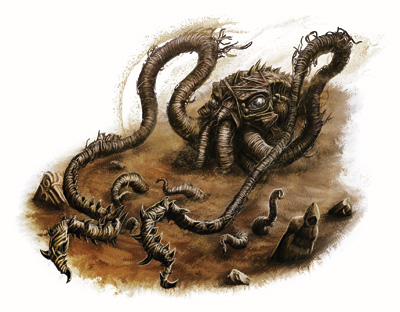 Gargantuan Undead
Hit Dice: 20d12+100 (230 hp)
Initiative: +4
Speed: 20 ft. (4 squares), burrow 20 ft.
Armor Class: 30 (-4 size, +24 natural), touch 6, flatfooted 30
Base Attack/Grapple: +10/+34
Attack: Tentacle +18 melee (2d8+12/19-20 plus mummy rot)
Full Attack: 2 tentacles +18 melee (2d8+12/19-20 plus mummy rot) and 6 arms +13 melee (1d6+6)
Space/Reach: 20 ft./15 ft. (25 ft. with tentacles)
Special Attacks: Despair, mummy rot
Special Qualities: Damage reduction 5/—, darkvision 60 ft., fast healing 10, undead traits, unholy toughness, vulnerability to fire
Saves: Fort +6, Ref +6, Will +17
Abilities: Str 34, Dex 10, Con —, Int 6, Wis 20, Cha 20
Skills: Listen +18, Spot +19
Feats: Alertness, Blind-Fight, Combat Expertise, Improved Critical (tentacle), Improved Initiative, Improved Trip, Iron Will
Environment: Warm deserts
Organization: Solitary
Challenge Rating: 11
Treasure: Standard
Alignment: Always lawful evil
Advancement: 21-32 HD (Gargantuan); 33-60 HD (Colossal)
Level Adjustment: —
Gargantuan Undead
Hit Dice: 20d12+100 (230 hp)
Initiative: +4
Speed: 20 ft. (4 squares), burrow 20 ft.
Armor Class: 30 (-4 size, +24 natural), touch 6, flatfooted 30
Base Attack/Grapple: +10/+34
Attack: Tentacle +18 melee (2d8+12/19-20 plus mummy rot)
Full Attack: 2 tentacles +18 melee (2d8+12/19-20 plus mummy rot) and 6 arms +13 melee (1d6+6)
Space/Reach: 20 ft./15 ft. (25 ft. with tentacles)
Special Attacks: Despair, mummy rot
Special Qualities: Damage reduction 5/—, darkvision 60 ft., fast healing 10, undead traits, unholy toughness, vulnerability to fire
Saves: Fort +6, Ref +6, Will +17
Abilities: Str 34, Dex 10, Con —, Int 6, Wis 20, Cha 20
Skills: Listen +18, Spot +19
Feats: Alertness, Blind-Fight, Combat Expertise, Improved Critical (tentacle), Improved Initiative, Improved Trip, Iron Will
Environment: Warm deserts
Organization: Solitary
Challenge Rating: 11
Treasure: Standard
Alignment: Always lawful evil
Advancement: 21-32 HD (Gargantuan); 33-60 HD (Colossal)
Level Adjustment: —
A horrific nest of withered, desiccated tentacles heaves from the sand. Behind the tentacles is a barrellike body wrapped in centuriesold funeral dressings. Two staring orbs surmount the gargantuan form, promising annihilation.
A few crawling apocalypses yet traverse the trackless sands, self-impelled immortal remnants of ancient wars.
Each crawling apocalypse is actually a war machine created by a race called the marru. Known for their power over the flesh of the living, splinter factions of marru wandered into realms of necromancy, and in their madness to win at any cost, they introduced monstrosities of the sea to mummification and the sea of sand. Too potent to perish with the conclusion of the wars and the eradication of their creators, crawling apocalypses yet patrol ancient perimeters, guarding against intrusion by enemies long vanished.
While some roving weapons of the ancient marru still sometimes rise to the surface and cause desolation, most remaining crawling apocalypses arc secreted in ancient weapon depots, well hidden thousands of feet below the desert surface. They have vague memories of their former living existence, thousands of years ago. The memory of their former mastery, and what was taken from them, fuels their violence against all creatures. Some could still respond to command codes devised by the marru, though those codes are most likely all forgotten.
COMBAT
Crawling apocalypses strike their opponents with their barbed tentacles, which, in addition to dealing awful damage, can also infect foes with diseases from beyond the grave.
Despair (Su): At the mere sight of a crawling apocalypse, a creature must succeed on a DC 25 Will save or be paralyzed with fear for 1d4 rounds. Whether or not the save is successful, that creature cannot be affected again by that same crawling apocalypse's despair ability for 24 hours. The save DC is Charisma-based.
Mummy Rot (Su): Supernatural disease—tentacles. Fortitude DC 25, incubation period 1 minute, damage 1d6 Con and 1d6 Cha. The save DC is Charisma-based. Unlike normal diseases, mummy rot continues until the victim reaches Constitution 0 (and dies) or is cured as described on page 190 of the Monster Manual.
Unholy Toughness (Ex): A crawling apocalypse gains a bonus to its hit points equal to its Charisma modifier tiroes its Hit Dice (already figured).
CRUCIAN |
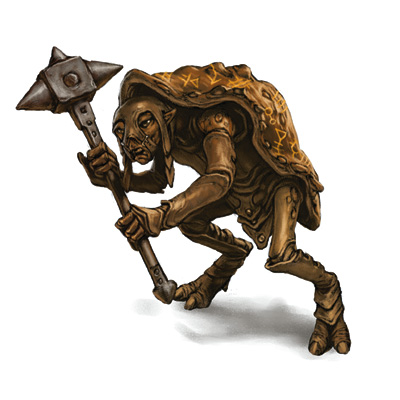 Medium Humanoid
Hit Dice: 3d8+9 (22 hp)
Initiative: -1
Speed: 20 ft. (4 squares)
Armor Class: 21 (-1 Dex, +8 natural, +2 leather, +2 heavy shield), touch 9, flat-footed 21
Base Attack/Grapple: +2/+4
Attack: Warhammer +5 melee (1d8+2/x3)
Full Attack: Warhammer +5 melee (1d8+2/x3)
Space/Reach: 5 ft./5 ft.
Special Attacks: —
Special Qualities: Low-light vision
Saves: Fort +6, Ref +0, Will +3
Abilities: Str 15, Dex 8, Con 17, Int 11, Wis 10, Cha 8
Skills: Diplomacy +1, Sense Motive +6, Spot +6
Feats: Iron Will, Weapon Focus (warhammer)
Environment: Warm deserts
Organization: Pair, crew (2-5 plus 50% chance for 1 4thlevel leader), squad (5-10 plus 1 4th level leader plus 50% chance tor 1 5th-level leader)
Challenge Rating: 2
Treasure: 50% coins, double goods, 50% items
Alignment: Usually lawful neutral
Advancement: By character class
Level Adjustment: +2
Medium Humanoid
Hit Dice: 3d8+9 (22 hp)
Initiative: -1
Speed: 20 ft. (4 squares)
Armor Class: 21 (-1 Dex, +8 natural, +2 leather, +2 heavy shield), touch 9, flat-footed 21
Base Attack/Grapple: +2/+4
Attack: Warhammer +5 melee (1d8+2/x3)
Full Attack: Warhammer +5 melee (1d8+2/x3)
Space/Reach: 5 ft./5 ft.
Special Attacks: —
Special Qualities: Low-light vision
Saves: Fort +6, Ref +0, Will +3
Abilities: Str 15, Dex 8, Con 17, Int 11, Wis 10, Cha 8
Skills: Diplomacy +1, Sense Motive +6, Spot +6
Feats: Iron Will, Weapon Focus (warhammer)
Environment: Warm deserts
Organization: Pair, crew (2-5 plus 50% chance for 1 4thlevel leader), squad (5-10 plus 1 4th level leader plus 50% chance tor 1 5th-level leader)
Challenge Rating: 2
Treasure: 50% coins, double goods, 50% items
Alignment: Usually lawful neutral
Advancement: By character class
Level Adjustment: +2
A crablike shell covers the upper body of this otherwise humanoid form. Its shell is heavily inscribed and painted, and it wears simple equipment and clothing.
Comfortable in the brutal heat of the desert, battle-hardened crucians rely on their natural shell armor to protect them in all situations.
Crucians are humanoids that sport broad, flat shells, like desert crabs, encompassing their upper bodies in natural protection. Not content with just their shells, they often wear additional leather chaps and armlets to protect the rest of their bodies. They decorate their shells with brightly colored painted sigils, as well as deeply etched tallies of their personal triumphs on the sandy field of conflict. Most crucians prefer to wield enormous warhammers, weighted to crack even the hardest enemy shells.
Crucians are highly territorial, and they organize into small bands, each group protecting a prized water source. Crucian bands regularly raid one another's oases, which accounts for their warlike demeanor. Every twenty years or so, a leader rises among the crucians and forges the various bands into a mighty force. This crucian army strikes out into cooler lands for booty and conquest, only to fall back into the desert once the creatures have wreaked their fill of misery.
In negotiations, crucians are known to be cunning. They often employ verbal feints to draw others out and get a better read on them, and they are keenly interested in figuring out how both friends and enemies think. Crucians speak Common and Draconic. More intelligent crucians learn Sphinx, the language of the creatures that share their desert homes.
COMBAT
When they can, crucians prefer to attack as a solid line to prevent enemies from getting at their flanks.
CRUCIAN CHARACTERS
Crucian characters possess the following racial traits.
-
+4 Strength, -2 Dexterity, +6 Constitution, -2 Charisma
-
Medium size.
-
Low-light vision.
-
+8 natural armor. A crucian's crablike shell gives it remarkable protection.
-
Automatic Languages: Common and Draconic. Bonus Language: Sphinx.
-
Favored Class: Druid.
-
Level adjustment +2.
CURSED COLD ONE (GELUN) |
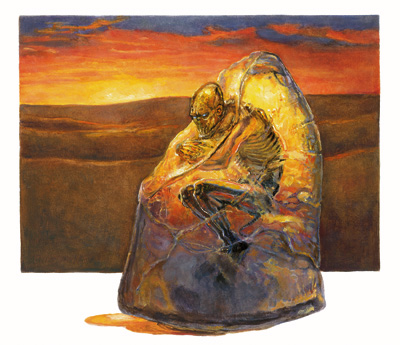 Medium Aberration
Hit Dice: 5d8+3 (25 hp)
Initiative: +4
Speed: 30 ft. (6 squares)
Armor Class: 20 (+4 Dex, +6 natural), touch 14, flat-footed 16
Base Attack/Grapple: +3/+5
Attack: Slam +5 melee (1d4+3 plus 1d6 cold)
Full Attack: Slam +5 melee (1d4+3 plus 1d6 cold)
Space/Reach: 5 ft./5 ft.
Special Attacks: Heat-sucking claw, icy gaze
Special Qualities: Darkvision 60 ft., heat reliant, immunity to fire, vulnerability to cold
Saves: Fort +1, Ref +5, Will +5
Abilities: Str 14, Dex 18, Con 11, Int 7,Wis 12. Cha 14
Skills: Listen +4, Sense Motive +3, Spot +4
Feats: Dodge, Toughness
Environment: Warm deserts
Organization: Solitary
Challenge Rating: 3
Treasure: Standard
Alignment: Usually neutral
Advancement: By character class
Level Adjustment: +2
Medium Aberration
Hit Dice: 5d8+3 (25 hp)
Initiative: +4
Speed: 30 ft. (6 squares)
Armor Class: 20 (+4 Dex, +6 natural), touch 14, flat-footed 16
Base Attack/Grapple: +3/+5
Attack: Slam +5 melee (1d4+3 plus 1d6 cold)
Full Attack: Slam +5 melee (1d4+3 plus 1d6 cold)
Space/Reach: 5 ft./5 ft.
Special Attacks: Heat-sucking claw, icy gaze
Special Qualities: Darkvision 60 ft., heat reliant, immunity to fire, vulnerability to cold
Saves: Fort +1, Ref +5, Will +5
Abilities: Str 14, Dex 18, Con 11, Int 7,Wis 12. Cha 14
Skills: Listen +4, Sense Motive +3, Spot +4
Feats: Dodge, Toughness
Environment: Warm deserts
Organization: Solitary
Challenge Rating: 3
Treasure: Standard
Alignment: Usually neutral
Advancement: By character class
Level Adjustment: +2
A slab of ice stands upright in the sand. Within it is a humanoid shape, curled up in a ball. The humanoid is nearly as transparent and smooth as the ice itself, but its eyes ore open, and they are as blue and cold as a mountain glacier.
Cursed cold ones were humanoids once, before their blood was cursed and their forms changed to suit their new reliance on warmth and heat. Such is their curse—their bodies are heat sinks, so much so that should they ever venture into an environment coo cold, they would freeze immobile, entering a timeless stasis until the surrounding temperature rises enough to thaw them.
The name "cursed cold one" was given to these creatures by others; they call themselves geluns. A gelun is sufficient unto itself, requiring only warmth to remain conscious and active. This reliance on warmth means that geluns inhabit warm regions, and all known gelun conclaves are in warm desert lands. Bitter at their enforced and permanent exile to the waste, cursed cold ones are usually hostile to other creatures, especially those native to temperate environments.
Geluns live in conclaves out in the open sands where shadows are scarce and the heat is the fiercest. Even then, many conclaves must suffer through cold desert nights, where the temperature drops so much that all present risk freezing solid until the rising sun returns their mobility. Great bonfires at the center of each conclave usually forestall this event, but bonfires require good supplies of coke or wood, which means foraging, raiding, and sometimes trade.
As to the nature of the supposed curse that created their race, no living gelun can say for certain, though many stories (each widely different) circulate among gelun conclaves.
Cursed cold ones speak a dialect of Common.
COMBAT
Geluns rely on their icy claws and frigid gaze in combat.
Heat Reliant (Ex): Unless a cursed cold one inhabits an environment where the temperature remains above 110 degrees F, it frosts over and freezes solid, entering a state of extreme hibernation. It is extremely vulnerable during such periods, essentially helpless. On the other hand, while enjoying environments of severe heal or hotter, cursed cold ones function normally, gaining all the nutrition and energy they need from the warmth itself.
Heat-Sucking Claw (Ex): The frost-coated nails of a cursed cold one deal an extra 1d6 points of cold damage whenever the creature deals slam damage in melee.
Icy Gaze (Su): Dazed (with cold) for 1 round, 30 feet, Will DC 14 negates. The save DC is Charisma-based. Any creature meeting the gaze of a cursed cold one is subject to its icy gaze attack. A cursed cold one can use a standard action to focus its icy gaze on an opponent and attack with its icy slam at the same time.
Immunity to Fire (Ex): Any magical attack that deals fire damage to a cursed cold one heals 1 point of damage for each 3 points of damage the attack would otherwise deal. If the amount of healing would cause a cursed cold one to exceed its full normal hit points, it gains any excess as temporary hit points. A cursed cold one can only gain temporary hit points from this ability equal to its full normal hit points (25 extra hit points for an average cursed cold one). Temporary hit points gained in this fashion last for 1 hour. For example, a cursed cold one hit by a fireball gains back 6 hit points if the damage total is 18 points. A cursed cold one gets no saving throw against fire effects.
Vulnerability to Cold (Ex): A cursed cold one takes half again as much (+50%) damage as normal from the effect, regardless of whether a saving throw is allowed, or if the save is a success or failure. It a cursed cold one fails its save against a cold effect, it is also dazed for 1 round.
DESERT DEVIL (ARATON) |
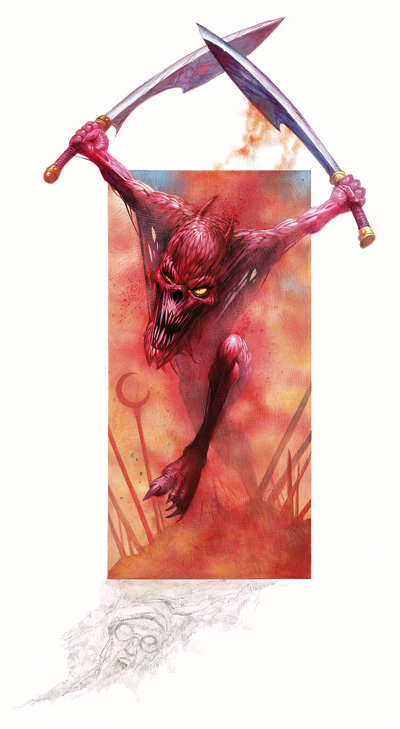 Medium Outsider (Evil, Extraplanar, Lawful)
Hit Dice: 8d8+24 (60 hp)
Initiative: +6
Speed: 30 ft. (6 squares)
Armor Class: 22 (+2 Dex, +10 natural), touch 12, flatfooted 20
Base Attack/Grapple: +8/+10
Attack: Scimitar +11 melee (1d6+2/ 18-20)
Full Attack: 2 scimitars +7 melee (1d6+2/18-20)
Space/Reach: 5 ft./5 ft.
Special Attacks: Desert halo
Special Qualities: Damage reduction 5/silver or good, darkvision 60 ft., immunity to fire, regeneration 3, spell resistance 16
Saves: Fort +9, Ref +8, Will +6
Abilities: Str 15, Dex 15, Con 16, Int 6,Wis 10, Cha 12
Skills: Balance +4, Climb +13, Escape Artist +13, Intimidate +12, Jump + 4, Listen +13, Spot +13, Tumble +13, Use Rope +2 (+4 involving bindings)
Feats: Alertness, Improved Initiative, Weapon Focus (scimitar), Whirlwind AttackB
Environment: Nine Hells of Baator
Organization: Solitary
Challenge Rating: 6
Treasure: Standard
Alignment: Always lawful evil
Advancement: 9-16 HD (Medium); 17-24 HD (Large)
Level Adjustment: +6
Medium Outsider (Evil, Extraplanar, Lawful)
Hit Dice: 8d8+24 (60 hp)
Initiative: +6
Speed: 30 ft. (6 squares)
Armor Class: 22 (+2 Dex, +10 natural), touch 12, flatfooted 20
Base Attack/Grapple: +8/+10
Attack: Scimitar +11 melee (1d6+2/ 18-20)
Full Attack: 2 scimitars +7 melee (1d6+2/18-20)
Space/Reach: 5 ft./5 ft.
Special Attacks: Desert halo
Special Qualities: Damage reduction 5/silver or good, darkvision 60 ft., immunity to fire, regeneration 3, spell resistance 16
Saves: Fort +9, Ref +8, Will +6
Abilities: Str 15, Dex 15, Con 16, Int 6,Wis 10, Cha 12
Skills: Balance +4, Climb +13, Escape Artist +13, Intimidate +12, Jump + 4, Listen +13, Spot +13, Tumble +13, Use Rope +2 (+4 involving bindings)
Feats: Alertness, Improved Initiative, Weapon Focus (scimitar), Whirlwind AttackB
Environment: Nine Hells of Baator
Organization: Solitary
Challenge Rating: 6
Treasure: Standard
Alignment: Always lawful evil
Advancement: 9-16 HD (Medium); 17-24 HD (Large)
Level Adjustment: +6
The howl and scream of sand heralds the approach of this creature. Swathed in a halo of blowing grit and dust, a humanoid with flayed, sand-blasted flesh appears. In each of its hands, it wields a scimitar red with the its own constantly oozing blood.
These sandstorm-cloaked devils are sometimes mistaken tor undead because the sands that swirl about them constantly flay their gruesome bodies. Only a desert devil's power of regeneration keeps it healthy. Desert devils are actually humanlike devils that wear nothing but shrouding sand. They are sometimes called aratons. A desert devil stands roughly 6 feet tall and weighs about 190 pounds.
Aratons speak Infernal and Common.
COMBAT
A desert devil attacks with its whirling, deadly scimitars. A desert devil's scimitars are treated as evil-aligned and lawful-aligned for the purpose of overcoming damage reduction.
Desert Halo (Su): A halo of abrasive dust swirls and screams around the araton in a 10-footradius spread. The swirling dust abrades any creature within it or attempting to move through it. Any creature passing through the haze takes 2d6 points of damage per round from the abrasive sand.
Regeneration (Ex): Desert devils take normal damage from silvered weapons, good-aligned weapons, and spells or effects with the good descriptor.
A desert devil that loses a piece of its body regrows it in 2d6+10 minutes. Holding the severed member against the stump enables it to reattach instantly.
DINOSAUR |
Some dinosaurs prefer the waste because it offers what most dinosaurs seek: rugged, isolated areas that humanoids seldom visit.
PROTOCERATOPS
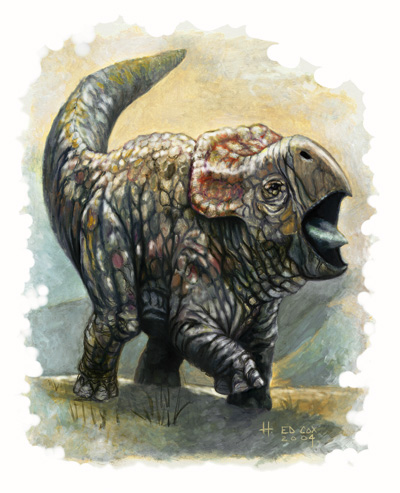 Medium Animal
Hit Dice: 5d8+20 (42 hp)
Initiative: +0
Speed: 30 ft. (6 squares)
Armor Class: 18 (+8 natural), touch 10, flat-footed 18
Base Attack/Grapple: +3/+6
Attack: Bite +6 melee (1d8+4)
Full Attack: Bite +6 melee (1d8+4)
Space/Reach: 5 ft./5 ft.
Special Attacks: Powerful charge
Special Qualities: Low-light vision, scent
Saves: Fort +8, Ref +4, Will +2
Abilities: Str 16, Dex 11, Con 19, Int 1, Wis 12, Cha 6
Skills: Listen +5, Spot +5, Survival +9
Feats: Alertness, Endurance
Environment: Warm deserts
Organization: Solitary, pair, or herd (4-7)
Challenge Rating: 3
Treasure: None
Alignment: Always neutral
Advancement: 6-10 HD (Medium); 11-15 HD (Large)
Level Adjustment: —
Medium Animal
Hit Dice: 5d8+20 (42 hp)
Initiative: +0
Speed: 30 ft. (6 squares)
Armor Class: 18 (+8 natural), touch 10, flat-footed 18
Base Attack/Grapple: +3/+6
Attack: Bite +6 melee (1d8+4)
Full Attack: Bite +6 melee (1d8+4)
Space/Reach: 5 ft./5 ft.
Special Attacks: Powerful charge
Special Qualities: Low-light vision, scent
Saves: Fort +8, Ref +4, Will +2
Abilities: Str 16, Dex 11, Con 19, Int 1, Wis 12, Cha 6
Skills: Listen +5, Spot +5, Survival +9
Feats: Alertness, Endurance
Environment: Warm deserts
Organization: Solitary, pair, or herd (4-7)
Challenge Rating: 3
Treasure: None
Alignment: Always neutral
Advancement: 6-10 HD (Medium); 11-15 HD (Large)
Level Adjustment: —
This beast looks like a small triceratops, with a bony frill behind its head and a sharp beaked mouth. It lacks the triceratops's horns, however, and is roughly the size of a large dog.
Protoceratops is a desert-dwelling herbivorous dinosaur that roots for tubers below the baked earth and grazes on the rough leaves of desert weeds. It has a thick, bony skull and a tough hide to protect it from climate and predators.
A protoceratops is 6 to 8 feet long and weighs about 900 pounds.
Combat
Protoceratops are not very aggressive, but because they are the favored prey of larger creatures, they have developed effective defenses. A threatened protoceratops lowers its head and charges, attempting to bull rush an enemy and escape. If it cannot get away, it attempts to charge as often as possible.
Powerful Charge (Ex): A protoceratops deals 2d8+11 points of damage when it makes a charge.
Skills: Protoceratops have a +4 racial bonus on Survival checks.
DIPROTODON
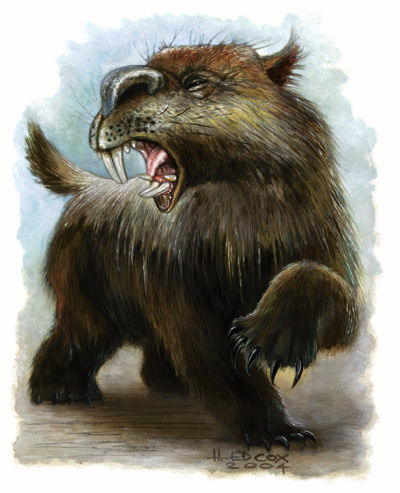 Large Animal
Hit Dice: 9d8+36 (76 hp)
Initiative: +0
Speed: 40 ft. (8 squares), burrow 10 ft.
Armor Class: 14 (-1 size, +5 natural), touch 9, flatfooted 14
Base Attack/Grapple: +6/+18
Attack: Gore +13 melee (1d8+8)
Full Attack: Gore +13 melee (1d8+8) and 2 claws +8 melee (1d8+4)
Space/Reach: 10 ft./5 ft.
Special Attacks: Trample 2d6+12
Special Qualities: Low-light vision, scent
Saves: Fort +10, Ref +6, Will +6
Abilities: Str 27, Dex 10, Con 18, Int 2, Wis 13, Cha 11
Skills: Listen +9, Spot +9
Feats: Alertness, Improved Natural Attack (claw), Iron Will, Run
Environment: Warm deserts
Organization: Solitary or pair
Challenge Rating: 5
Treasure: None
Alignment: Always neutral
Advancement: 12-18 HD (Large); 19-27 HD (Huge)
Level Adjustment: —
Large Animal
Hit Dice: 9d8+36 (76 hp)
Initiative: +0
Speed: 40 ft. (8 squares), burrow 10 ft.
Armor Class: 14 (-1 size, +5 natural), touch 9, flatfooted 14
Base Attack/Grapple: +6/+18
Attack: Gore +13 melee (1d8+8)
Full Attack: Gore +13 melee (1d8+8) and 2 claws +8 melee (1d8+4)
Space/Reach: 10 ft./5 ft.
Special Attacks: Trample 2d6+12
Special Qualities: Low-light vision, scent
Saves: Fort +10, Ref +6, Will +6
Abilities: Str 27, Dex 10, Con 18, Int 2, Wis 13, Cha 11
Skills: Listen +9, Spot +9
Feats: Alertness, Improved Natural Attack (claw), Iron Will, Run
Environment: Warm deserts
Organization: Solitary or pair
Challenge Rating: 5
Treasure: None
Alignment: Always neutral
Advancement: 12-18 HD (Large); 19-27 HD (Huge)
Level Adjustment: —
This hippopotamus-sized beast is covered with short, grizzled fur. Its thick legs end in massive digging claws, and two large tusks project horizontally from its lower jaw. It shakes its head threateningly and prepares to charge.
A diprotodon is a giant relative of the wombat, an herbivorous, powerfully built marsupial. Diprotodons are built to graze dry grasses and other tough desert vegetation. Their powerful teeth grind the fibrous plant matter to a fine pulp, and their digestive systems slowly process the food, extracting every drop of water and scrap of nourishment. Their powerful legs and claws are built for digging, and a diprotodons habitat is easy to identify from the large entrances to its nesting burrow.
Combat
Although mild mannered in general, a diprotodon is intensely territorial and does not hesitate to stamp an intruder into the ground. A diprotodon can move as quickly as a camel, despite its lumbering appearance, and when it charges, it often catches opponents off guard.
Trample (Ex): Reflex half DC 22. The save DC is Strength-based.
DIRE ANIMAL |
Dire animals are larger, tougher, meaner versions of ordinary animals. In the waste, each kind tends to have a feral, parched, or even scorched appearance.
DIRE HIPPOPOTAMUS
Huge Animal Hit Dice: 18d8+126 (207 hp) Initiative: -2 Speed: 30 ft. (6 squares), swim 30 ft. Armor Class: 18 (-2 size, -2 Dex, +12 natural), touch 6, flat-footed 18 Base Attack/Grapple: +13/+-33 Attack: Bite +23 melee (2d8+12/19-20) Full Attack: Bite +23 melee (2d8+12/19-20) Space/Reach: 15 ft./10 ft. Special Attacks: Improved grab Special Qualities: Hold breath, scent Saves: Fort +18, Ref +9, Will +8 Abilities: Str 34, Dex 6, Con 25, Int 2, Wis 14, Cha 8 Skills: Listen +15, Spot +14, Swim +20 Feats: Alertness, Die Hard, Endurance, Improved Bull Rush, Improved Critical, Improved Overrun, Power Attack Environment: Warm plains and forests (rivers) Organization: Solitary or pair Challenge Rating: 14 Alignment: Always neutral Advancement: 19-26 HD (Huge); 27-54 HD (Gargantuan) Level Adjustment: —A double row of horny ridges run along the back of this hulking hippopotamus, and it has a gaping maw large enough to snap a timber in two.
Unlike its smaller cousin, a dire hippopotamus is not content to dine on plants. It is a carnivore, subsisting mainly on fish and small mammals—or even big mammals, if they venture too close to the rivers, ponds, and lakes in which dire hippos dwell. Territorial and aggressive in the extreme, dire hippos attack anything that comes near. A typical dire hippo is over 20 feet long and weighs between four and six tons.
Combat
Dire hippopotami lurk submerged near the shores of their habitats, waiting for prey to come to the water to drink (usually just after dusk and just before dawn). Though not particularly stealthy, they are usually obscured by the water, allowing them to get close enough for a sudden, brutal attack—which is often more than enough.
Improved Grab (Ex): To use this ability, a dire hippopotamus must hit with its bite attack. It can then attempt to start a grapple as a free action without provoking attacks of opportunity.
Hold Breath (Ex): A dire hippopotamus can hold its breath for a number of rounds equal to 8 x its Constitution score before it risks drowning.
Skills: A dire hippopotamus has a +8 racial bonus on any Swim check to perform some special action or avoid a hazard. It can always choose to take 10 on a Swim check, even if distracted or endangered. It can use the run action while swimming, provided it swims in a straight line.
DIRE JACKAL
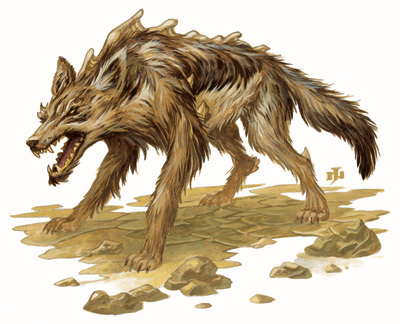 Large Animal
Hit Dice: 4d8+8 (26 hp)
Initiative: +2
Speed: 60 ft (12 squares)
Armor Class: 13 (-1 size, +2 Dex, +2 natural), touch 11, flat-footed 11
Base Attack/Grapple: +3/+12
Attack: Bite +7 melee (1d6+5)
Full Attack: Bite +7 melee (1d6+5)
Space/Reach: 10 ft./5 ft.
Special Attacks: Trip
Special Qualities: Low-light vision, scent
Saves: Fort +6, Ref +6, Will +5
Abilities: Str 20, Dex 14, Con 15, Int 2, Wis 13, Cha 8
Skills: Jump +10, Listen +5, Spot +5, Survival +3
Feats: Alertness, Track
Environment: Warm deserts
Organization: Solitary or pair
Challenge Rating: 2
Alignment: Always neutral
Advancement: 5-9 HD (Large); 10-12 HD (Huge)
Level Adjustment: —
Large Animal
Hit Dice: 4d8+8 (26 hp)
Initiative: +2
Speed: 60 ft (12 squares)
Armor Class: 13 (-1 size, +2 Dex, +2 natural), touch 11, flat-footed 11
Base Attack/Grapple: +3/+12
Attack: Bite +7 melee (1d6+5)
Full Attack: Bite +7 melee (1d6+5)
Space/Reach: 10 ft./5 ft.
Special Attacks: Trip
Special Qualities: Low-light vision, scent
Saves: Fort +6, Ref +6, Will +5
Abilities: Str 20, Dex 14, Con 15, Int 2, Wis 13, Cha 8
Skills: Jump +10, Listen +5, Spot +5, Survival +3
Feats: Alertness, Track
Environment: Warm deserts
Organization: Solitary or pair
Challenge Rating: 2
Alignment: Always neutral
Advancement: 5-9 HD (Large); 10-12 HD (Huge)
Level Adjustment: —
This hulking canine is as big as a pony, is covered in shaggy tan fur, and sports large, sharp teeth. Its ears fan bock as it bares its fangs in a hungry smile.
Dire jackals, unlike ordinary jackals, hunt fearlessly day or night, in any area, and are even so bold as to enter city dwellings in search of unguarded livestock—or even unprotected children. Their hunting cry fills their prey with dread, and civilized folk who hear it outside their tents know that death is nearby.
Combat
Dire jackals hunt alone or in mated pairs. Like ordinary jackals, they chase prey until it is exhausted, or work together to flank their opponents. Trip (Ex): A dire jackal that hits with a bite attack can attempt to trip its opponent (+9 check modifier) as a free action without making a touch attack or provoking attacks of opportunity. If the attempt fails, the opponent cannot react to trip the dire jackal.
Skills: Dire jackals have a +4 racial bonus on Jump checks. Jackals have a +4 racial bonus on Survival checks when tracking by scent.
DIRE PUMA
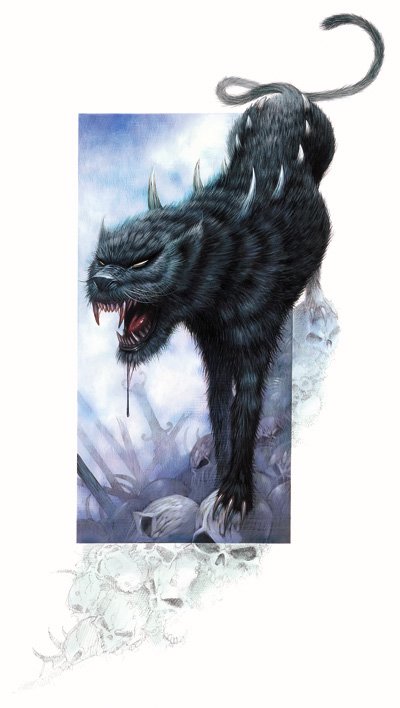 Large Animal
Hit Dice: 6d8+24 (51 hp)
Initiative: +3
Speed: 50 ft. (10 squares), climb 20 ft.
Armor Class: 16 (-1 size, +3 Dex, +4 natural), touch 12, flat-footed 13
Base Attack/Grapple: +4/+13
Attack: Bite +9 melee (1d8+5)
Full Attack: Bite +9 melee (1d8+5)and 2 claws +3 melee (1d6+2)
Space/Reach: 10 ft./5 ft.
Special Attacks: Improved grab, pounce, rake 1d6+2
Special Qualities: Low-light vision, scent
Saves: Fort +9, Ref +8, Will +6
Abilities: Str 20, Dex 17, Con 19, Int 2, Wis 12, Cha 6
Skills: Balance +11, Climb +21, Hide +3, Listen +5, Move Silently +7, Spot +5
Feats: Alertness, Track, Weapon Focus (bite)
Environment: Warm hills
Organization: Solitary or pair
Challenge Rating: 4
Treasure: None
Alignment: Always neutral
Advancement: 7-12 HD (Large); 13-18 HD (Huge)
Level Adjustment: —
Large Animal
Hit Dice: 6d8+24 (51 hp)
Initiative: +3
Speed: 50 ft. (10 squares), climb 20 ft.
Armor Class: 16 (-1 size, +3 Dex, +4 natural), touch 12, flat-footed 13
Base Attack/Grapple: +4/+13
Attack: Bite +9 melee (1d8+5)
Full Attack: Bite +9 melee (1d8+5)and 2 claws +3 melee (1d6+2)
Space/Reach: 10 ft./5 ft.
Special Attacks: Improved grab, pounce, rake 1d6+2
Special Qualities: Low-light vision, scent
Saves: Fort +9, Ref +8, Will +6
Abilities: Str 20, Dex 17, Con 19, Int 2, Wis 12, Cha 6
Skills: Balance +11, Climb +21, Hide +3, Listen +5, Move Silently +7, Spot +5
Feats: Alertness, Track, Weapon Focus (bite)
Environment: Warm hills
Organization: Solitary or pair
Challenge Rating: 4
Treasure: None
Alignment: Always neutral
Advancement: 7-12 HD (Large); 13-18 HD (Huge)
Level Adjustment: —
This giant cougar is as black as night, with glowing yellow eyes and outsized fangs. Spiked ridges protrude from its arched back.
Dire pumas are terrifying, vicious creatures that stalk their prey relentlessly. A dire puma is about 8 feet long and weighs about 600 pounds.
Combat
Dire pumas spring upon their prey from a height if possible. They hunt at night.
Improved Grab (Ex): To use this ability, a dire puma must hit with its bite attack. It can then attempt to start a grapple as a free action without provoking attacks of opportunity. If it wins the grapple check, it establishes a hold and can rake.
Pounce (Ex): If a dire puma charges a foe, it can make a full attack, including two rake attacks.
Rake (Ex): Attack bonus +9, damage 1d6+2.
Skills: Dire pumas have a +8 racial bonus on Jump checks and a +4 racial bonus on Move Silently checks. Dire pumas have a +8 racial bonus on Balance and Climb checks. They can always choose to take 10 on a Climb check, even it rushed or threatened. Dire pumas have a +4 racial bonus on Hide checks at night or in dark areas.
DIRE TORTOISE
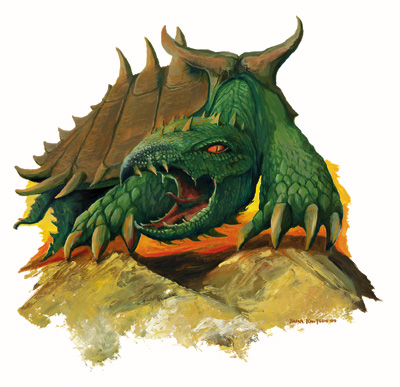 Huge Animal
Hit Dice: 14d8+107 (170 hp)
Initiative: -2
Speed: 20 ft. (4 squares), burrow 20 ft.
Armor Class: 25 (-2 size, -2 Dex, +19 natural), touch 6, flat-footed 25
Base Attack/Grapple: +10/+26
Attack: Bite +16 melee (1d8+12)
Full Attack: Bite +16 melee (1d8+12)
Space/Reach: 15 ft./10 ft.
Special Attacks: Lightning strike, trample 4d8+12
Special Qualities: Low-light vision
Saves: Fort +16, Ref +7, Will +9
Abilities: Str 26, Dex 6, Con 25, Int 2, Wis 10, Cha 6
Skills: Hide -1, Listen +6, Spot +6
Feats: Alertness, Endurance, Toughness (3)
Environment: Warm deserts
Organization: Solitary or pair
Challenge Rating: 8
Treasure: None
Alignment: Always neutral
Advancement: 15-28 HD (Huge); 29-42 HD (Gargantuan)
Level Adjustment: —
Huge Animal
Hit Dice: 14d8+107 (170 hp)
Initiative: -2
Speed: 20 ft. (4 squares), burrow 20 ft.
Armor Class: 25 (-2 size, -2 Dex, +19 natural), touch 6, flat-footed 25
Base Attack/Grapple: +10/+26
Attack: Bite +16 melee (1d8+12)
Full Attack: Bite +16 melee (1d8+12)
Space/Reach: 15 ft./10 ft.
Special Attacks: Lightning strike, trample 4d8+12
Special Qualities: Low-light vision
Saves: Fort +16, Ref +7, Will +9
Abilities: Str 26, Dex 6, Con 25, Int 2, Wis 10, Cha 6
Skills: Hide -1, Listen +6, Spot +6
Feats: Alertness, Endurance, Toughness (3)
Environment: Warm deserts
Organization: Solitary or pair
Challenge Rating: 8
Treasure: None
Alignment: Always neutral
Advancement: 15-28 HD (Huge); 29-42 HD (Gargantuan)
Level Adjustment: —
This massive tortoise has a spiked, rocky shell as big as a house. Its large head ends in a wickedly sharp beak.
A dire tortoise moves slowly about the waste, consuming cactuses, mesquite shrubs, and tough desert grasses. It is an ill-tempered beast and quick to lash out at intruders.
A dire tortoise is 20 to 30 feet long and can weigh 12,000 pounds or more.
Combat
Dire tortoises rely on their camouflage and protection. If approached, they lunge suddenly at any creature within reach of their powerful jaws.
Lightning Strike (Ex): A dire tortoise can lash out very rapidly. On the first round of combat, it gets a surprise round regardless of whether it has been noticed. A creature that notices the dire tortoise is still treated as flat-footed during this round.
Trample (Ex): Reflex half DC 25. The save DC is Strength-based.
Skills: A dire tortoise has a +12 racial bonus on Hide checks in rocky terrain.
DIRE VULTURE
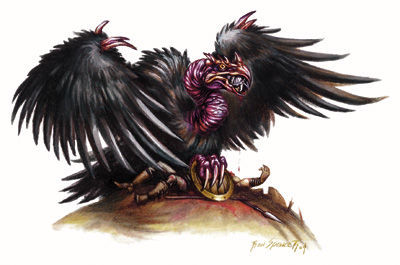 Large Animal
Hit Dice: 6d8+42 (69 hp)
Initiative: +1
Speed: 20 ft. (4 squares), fly 80 ft. (average)
Armor Class: 17 (-1 size, +1 Dex, +7 natural), touch 10, flat-footed 16
Base Attack/Grapple: +4/+11
Attack: Bite +6 melee (1d8+4)
Full Attack: Bite +6 melee (1d8+4)
Space/Reach: 10 ft./5 ft.
Special Attacks: Stench
Special Qualities: Low-light vision, resistance to disease, scent
Saves: Fort +12, Ref +6, Will +7
Abilities: Str 16, Dex 13, Con 25, Int 2, Wis 14, Cha 4
Skills: Listen +4, Spot +12, Survival +11
Feats: Alertness, Flyby Attack, Track
Environment: Warm deserts
Organization: Solitary or flock (4-20)
Challenge Rating: 3
Treasure: None
Alignment: Always neutral
Advancement: 7-12 HD (Large); 13-18 HD (Huge)
Level Adjustment: —
Large Animal
Hit Dice: 6d8+42 (69 hp)
Initiative: +1
Speed: 20 ft. (4 squares), fly 80 ft. (average)
Armor Class: 17 (-1 size, +1 Dex, +7 natural), touch 10, flat-footed 16
Base Attack/Grapple: +4/+11
Attack: Bite +6 melee (1d8+4)
Full Attack: Bite +6 melee (1d8+4)
Space/Reach: 10 ft./5 ft.
Special Attacks: Stench
Special Qualities: Low-light vision, resistance to disease, scent
Saves: Fort +12, Ref +6, Will +7
Abilities: Str 16, Dex 13, Con 25, Int 2, Wis 14, Cha 4
Skills: Listen +4, Spot +12, Survival +11
Feats: Alertness, Flyby Attack, Track
Environment: Warm deserts
Organization: Solitary or flock (4-20)
Challenge Rating: 3
Treasure: None
Alignment: Always neutral
Advancement: 7-12 HD (Large); 13-18 HD (Huge)
Level Adjustment: —
This enormous bird of prey has a mottled, naked head and neck with a wicked, hooked beak. A stink of carrion surrounds the beast.
A dire vulture, like its normal cousin, is a carrion feeder. It takes a very large carcass, or many small ones, to keep such a monster fed.
A dire vulture is 8 to 12 feet long and has a wingspan of 20 feet or more.
Combat
Dire vultures are much more aggressive than mundane vultures, and one might attack a creature that is two or more size categories smaller than itself.
Stench (Ex): Scraps of rotting flesh cling to a dire vulture's feathers, and the fetid wind of its wings can fell even the hardiest opponent. A creature within 20 feet of a dire vulture must succeed on a DC 20 Fortitude save or be sickened for ld6 rounds. A creature that successfully saves can't be affected by that dire vulture's stench ability for 24 hours. The save DC is Constitution-based.
Resistance to Disease (Ex): A dire vulture has a cast-iron stomach. It has a +2 bonus on Fortitude saves to resist normal diseases, but not supernatural or magical diseases such as mummy rot.
Skills: A dire vulture has a +4 racial bonus on Spot and Survival checks.
DRAGON, SAND |
| Age | Size | Hit Dice (hp) | Str | Dex | Con | Int | Wis | Cha | Base Attack/ Grapple |
Attack | Fort Save |
Ref Save |
Will Save |
Breath Weapon DC |
Frightful Presence DC |
|
|---|---|---|---|---|---|---|---|---|---|---|---|---|---|---|---|---|
| Wyrmling | T | 3d12 (19) | 10 | 11 | 11 | 10 | 10 | 10 | +3/-5 | +5 | +3 | +2 | +2 | 1d4 | (11) | — |
| Very young | S | 6d12+6 (45) | 12 | 11 | 11 | 10 | 12 | 10 | +6/+3 | +8 | +5 | +3 | +4 | 2d4 | (14) | — |
| Young | M | 9d12+9 (67) | 14 | 11 | 13 | 12 | 14 | 12 | +9/+11 | +11 | +8 | +5 | +7 | 4d4 | (15) | — |
| Juvenile | M | 12d12+24 (102) | 16 | 11 | 15 | 12 | 16 | 14 | +12/+15 | +15 | +12 | +7 | +10 | 6d4 | (18) | — |
| Young adult | L | 15d12+45 (142) | 20 | 11 | 17 | 14 | 16 | 14 | +15/+24 | +19 | +16 | +9 | +12 | 8d4 | (23) | 19 |
| Adult | L | 18d12+72 (189) | 24 | 11 | 19 | 14 | 18 | 16 | +18/+29 | +24 | +22 | +12 | +16 | 10d4 | (23) | 22 |
| Mature adult | H | 21d12+84 (220) | 28 | 11 | 19 | 16 | 18 | 16 | +21/+38 | +28 | +25 | +14 | +18 | 12d4 | (24) | 23 |
| Old | H | 24d12+120 (276) | 30 | 11 | 21 | 16 | 21 | 18 | +24/+42 | +32 | +29 | +16 | +21 | 14d4 | (27) | 26 |
| Very old | H | 27d12+135 (310) | 32 | 11 | 21 | 18 | 21 | 18 | +27/+46 | +36 | +32 | +18 | +23 | 16d4 | (28) | 27 |
| Ancient | H | 30d12+180 (375) | 34 | 11 | 23 | 18 | 24 | 20 | +30/+50 | +40 | +37 | +21 | +28 | 18d4 | (31) | 30 |
| Wyrm | G | 33d12+231 (445) | 36 | 11 | 25 | 20 | 24 | 20 | +33/+58 | +42 | +45 | +24 | +31 | 20d4 | (33) | 31 |
| Great wyrm | G | 36d12+252 (486) | 38 | 11 | 25 | 22 | 26 | 22 | +36/+62 | +46 | +47 | +27 | +40 | 22d4 | (36) | 34 |
| Age | Speed | Initiative | Armor Class | Special Abilities | Caster Level |
SR |
|---|---|---|---|---|---|---|
| Wyrmling | 30 ft., burrow 20 ft., fly 80 ft. (average) | +0 | 16 (+2 size, +4 natural) touch 12, flat-footed 16 | Immunity to fire, tremorsense 60 ft. | — | — |
| Very young | 30 ft., burrow 20 ft., fly 120 ft. (poor) | +0 | 18 (+1 size, +7 natural) touch 11 , flat-footed 18 | — | — | |
| Young | 30 ft., burrow 20 ft., fly 120 ft. (poor) | +0 | 20 (+10 natural) touch 10, flat-footed 20 | — | — | |
| Juvenile | 30 ft., burrow 20 ft., fly 120 ft. (poor) | +0 | 23 (+13 natural) touch 10, flat-footed 23 | Haboob | — | — |
| Young adult | 30 ft., burrow 20 ft., fly 120 ft. (poor) | +0 | 25 (-1 size, +16 natural) touch 9, flat-footed 25 | DR 5/magic | 1st | 18 |
| Adult | 30 ft., burrow 20 ft., fly 120 ft. (poor) | +0 | 28 (-1 size, +19 natural) touch 9, flat-footed 28 | Dispel water | 3rd | 20 |
| Mature adult | 30 ft., burrow 20 ft., fly 120 ft. (poor) | +0 | 30 (-2 size. +22 natural) touch 8, flat-footed 30 | DR 10/magic | 5th | 21 |
| Old | 30 ft., burrow 20 ft., fly 120 ft. (poor) | +0 | 33 (-2 size, +25 natural) touch 8, flat-footed 33 | Wall of sand | 7th | 23 |
| Very old | 30 ft., burrow 20 ft., fly 120 ft. (clumsy) | +0 | 36 (-2 size, +28 natural) touch 8, flat-footed 36 | DR 15/magic | 9th | 24 |
| Ancient | 30 ft., burrow 20 ft., fly 150 ft. (clumsy) | +0 | 38 (-2 size,+31 natural) touch 8, flat-footed 38 | Choking sands | 11th | 26 |
| Wyrm | 30 ft., burrow 20 ft., fly 150 ft. (clumsy) | +0 | 40 (-4 size, +34 natural) touch 6, flat-footed 40 | DR 20/magic | 13th | 27 |
| Great wyrm | 30 ft., burrow 20 ft., fly 150 ft. (clumsy) | +0 | 43 (-4 size. +37 natural) touch 6, flat-footed 43 | Sandstorm | 15th | 29 |
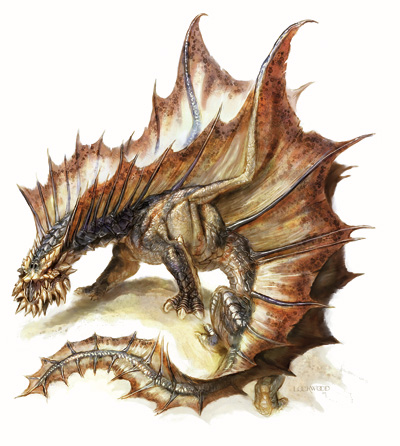
This dragon's head is a moss of thick, short horns in irregular rings around its snout, jaws, and neck, giving its entire head a distinct appearance reminiscent of a lamprey. Its large scales are a dark graybrown, and a crest of broad, short spines runs from its head to the tip of its tail. A membranous frill runs between these spines down the length of the dragon's body, allowing it to undulate through the air rather than flop like other dragons. The dragon smells of dust and dirt.
Sand dragons are violent, irritable, and cunning creatures, given to raiding farms for cattle, but leaving the farmers alive as a sign of "mercy" (never mind that the dragon has just devoured the farmer's livelihood). Not exactly evil, but definitely not good, sand dragons are motivated only by what is good for their own survival. In fact, they have a difficult time understanding why any living creature would think any other way.
Sand dragons lay their eggs deep within the sand of the desert, which is partly responsible for their name. As the eggs hatch, the hatchling dragons claw their way up to the surface, giving the impression that the dragons spring spontaneously from the sand. Even at that age, sand dragons have fully developed horns and claws, enabling them to burrow just as easily as their parents. Sand dragon wings are actually not wings at all, but thin membranes of a similar consistency and material to regular dragon wings. These membranes stretch between a double row of spikes that run the length of a sand dragon's back, from the base of its skull to the tip of its tail. These spines can collapse flat along a sand dragon's back when it burrows, protecting the fragile membranes from damage. A sand dragon can also lie flat on a sandy surface and flutter its wings to cover itself with sand, much as a stingray flutters its "wings" to conceal itself on the ocean floor.
In fact, sand dragons make their lairs under the sands, and only emerge to hunt or mate. As a result, sand dragons smell of freshly turned dirt and dust —not a particularly unpleasant smell, but a distinctive one. Due to their burrowing ability, sand dragons have little difficulty disguising their lairs; only their nostrils lie exposed (allowing them to breathe). When sand dragons travel underground—their primary means of sneaking up on prey—they simply hold their breath. Sand dragons are most fond of lizards and rodents, though the older they get, the larger the prey. Young adult and adult sand dragons eat goats and jackals, mature adult and older sand dragons go after cattle, camels, crocodiles, and even giant banded lizards (see page 164).
Sand dragons acquire a good deal of treasure, though they have no real use for it aside from bait for prey. They generally bury it in the sand under their lairs, and lie waiting for the sound of shovels digging toward them.
COMBAT
Sand dragons hunt by flying high above the ground, looking for herds of cattle or other concentrations of prey, then wait for nightfall to land and burrow up underneath their targets. Using their tremorsense to determine when an animal is in position, the sand dragon then bursts forth, snatches up the startled prey in its mouth or claws, and flies off to devour it in privacy. Alternatively, a sand dragon might locate a trade route and bury itself in the sand along the side of the road, waiting for a caravan to pass. Sand dragons rarely attack from the sky; there are simply too few clouds to provide the kind of concealment a sand dragon prefers.
Breath Weapon (Su): A sand dragon has one type of breath weapon, a cone of grit similar to a flay wind (see page 21).
Spell-Like Abilities:At will—haboob (juvenile or older); 3/day—dispel water (adult or older), wall of sand (old or older); 1/day—choking sands (ancient or older), sandstorm (great wyrm).
Skills: Concentration, Hide, Intimidate, Listen, Move Silently, Sense Motive, Spot, and Survival are considered class skills for sand dragons.
Adult Sand Dragon: CR 12; Large dragon (earth); HD 18d12+72; hp 189; Init +0; Spd 30 ft. (6 squares), burrow 20 ft., fly 120 ft. (poor); AC 28, touch 9, flat-footed 28; Base Atk +18; Grp +29; Atk +24 melee (2d6+7, bite); Full Atk +24 melee (2d6+7, bite), +19 melee (1d8+3, 2 claws), +19 melee (1d6+3, 2 wings), and +19 melee (1d8+10, tail slap); Space/Reach 10 ft./5 ft. (10 ft. with bite); SA breath weapon, spell-like abilities; SQ damage reduction 5/magic, darkvision 120 ft., immunity to fire, sleep, and paralysis, low-light vision, spell resistance 20, tremorsense 60 ft.; AL CN; SV Fort +22, Ref +12, Will +16; Str 24, Dex 11, Con 19, Int 14, Wis 18, Cha 16.
Skills and Feats: Climb +17, Hide +19, Intimidate +24, Knowledge (nature) +6, Listen 4 24, Move Silently +21, Spellcraft +12, Spot +24, Survival +25; Endurance, Flyby Attack, Improved Overrun, Power Attack, Snatch, Stealthy, Track.
Breath Weapon (Su): 40-ft. cone, damage 10d4, Reflex DC 23 half.
Spell-Like Abilities:At will—haboob (DC 16); 3/day— dispel water. Caster level 6th.
Frightful Presence (Ex): 180-ft. radius, HD 17 or fewer, Will DC 22 negates.
Spells:As 3rd-level sorcerer.
Typical Sorcerer Spells Known (6/6; caster level 3rd): 0—daze (DC 13), detect magic, flare (DC 13), ghost sound, read magic; 1st—locate water, mage armor, silent image (DC 14).
DRY LICH |
A dry lich is an especially horrid sort of undead spellcaster, and the ultimate destiny of a walker in the waste (see page 89).
A dry lich is not purposefully evil, but it is absorbed with its own agenda and has little regard for living things. It spends its unnatural existence continuing to spread the waste and preserve whatever it encounters as dry, mummified monuments. A dry lich is gaunt, skeletal, and usually humanoid (although some monstrous humanoids and aberrations occasionally follow the walker's path). Its flesh is parchment-dry and clings tightly to its bones, and a thick encrustation of glittering white salt covers its body. A weird green light lights its hollow eye sockets. It is garbed as it was in life, which is generally in a simple and practical costume rather than the ornate robes of typical liches. Dry lich clerics usually wear heavy armor, since walkers in the waste had immunity to dehydration and heat effects even before they became undead.
The mysterious Dusty Conclave closely guards the secret of becoming a dry lich, and at least one other dry lich must participate in another's creation. A dry lich speaks any languages it knew in life.
SAMPLE DRY LICH
This salt-crusted, skeletal horror shines with a terrible inner light as it plunges through a sand dune. Its empty sockets glow green in dreadful contrast.
This example uses an asherati cleric/walker in the waste as the base character.
Dry Lich, Asherati Cleric 5/Walker in the Waste 10
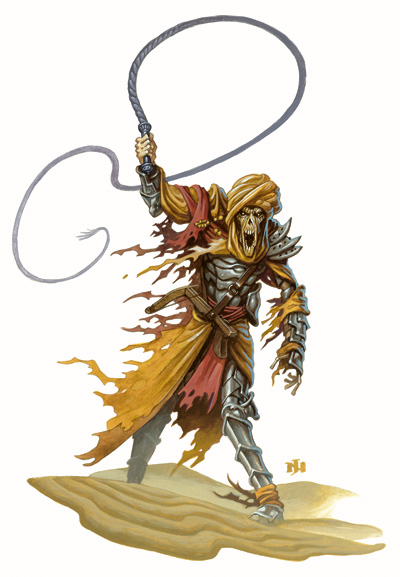 Medium Undead (Augmented Humanoid)
Hit Dice: 15d12+15 (112 hp)
Initiative: +0
Speed: 20 ft. in full plate (4 squares), base speed 30 ft.
Armor Class: 29 (+8 natural, +11 +3 full plate), touch 10, flat-footed 29
Base Attack/Grapple: +8/+10
Attack: Touch +10 melee (5d6 dehydration plus Constitution drain) or +1 scorpion-tail whip +11 melee (1d4+3 nonlethal plus poison) or light crossbow +8 ranged (1d8/19-20)
Full Attack: Touch +10 melee (5d6 dehydration plus Constitution drain) or +1 scorpion-tail whip +11/+6 melee (1d4+3 nonlethal plus poison) or light crossbow +8 ranged (1d8/19-20)
Space/Reach: 5 ft./5 ft.
Special Attacks: Aura of despair, Constitution drain, desiccating touch 5d6, greater drought, pillar of salt 1/day, rebuke undead 4/day (+5, 2d6+6, 5th), the wasting 1/day
Special Qualities: +6 turn resistance, asherati traits, body lamp, create sand golem, create salt mummy, damage reduction 10/bludgeoning and magic, darkvision 60 ft., fast healing 2, immunity to dessication, heat, polymorph, and mind-affecting spells and abilities, low-light vision, sandswim, undead traits, unholy toughness, water weakness, withered toughness
Saves: Fort +11, Ref +10, Will +20
Abilities: Str 14, Dex 10, Con —, Int 12, Wis 25, Cha 12
Skills: Concentration +12, (+16 casting defensively), Hide +5 (+7 sand), Intimidate +12, Knowledge (arcana) +6, Knowledge (geography) +6, Knowledge (nature) +6, Knowledge (religion) +7, Listen +15, Move Silently +5, Search +9, Spellcraft +13, Spot +15, Survival +15 (+17 to avoid becoming lost, aboveground)
Feats: Combat Casting, Heat EnduranceB, Exotic Weapon Proficiency (scorpion-tail whip), Improved Heat EnduranceB, Lightning Reflexes, Spell Penetration, Scorpion's Sense, Track
Environment: Warm deserts
Organization: Solitary
Challenge Rating: 18
Treasure: Standard coins; standard goods; double items
Alignment: Neutral evil
Advancement: By character class
Level Adjustment: +5
Medium Undead (Augmented Humanoid)
Hit Dice: 15d12+15 (112 hp)
Initiative: +0
Speed: 20 ft. in full plate (4 squares), base speed 30 ft.
Armor Class: 29 (+8 natural, +11 +3 full plate), touch 10, flat-footed 29
Base Attack/Grapple: +8/+10
Attack: Touch +10 melee (5d6 dehydration plus Constitution drain) or +1 scorpion-tail whip +11 melee (1d4+3 nonlethal plus poison) or light crossbow +8 ranged (1d8/19-20)
Full Attack: Touch +10 melee (5d6 dehydration plus Constitution drain) or +1 scorpion-tail whip +11/+6 melee (1d4+3 nonlethal plus poison) or light crossbow +8 ranged (1d8/19-20)
Space/Reach: 5 ft./5 ft.
Special Attacks: Aura of despair, Constitution drain, desiccating touch 5d6, greater drought, pillar of salt 1/day, rebuke undead 4/day (+5, 2d6+6, 5th), the wasting 1/day
Special Qualities: +6 turn resistance, asherati traits, body lamp, create sand golem, create salt mummy, damage reduction 10/bludgeoning and magic, darkvision 60 ft., fast healing 2, immunity to dessication, heat, polymorph, and mind-affecting spells and abilities, low-light vision, sandswim, undead traits, unholy toughness, water weakness, withered toughness
Saves: Fort +11, Ref +10, Will +20
Abilities: Str 14, Dex 10, Con —, Int 12, Wis 25, Cha 12
Skills: Concentration +12, (+16 casting defensively), Hide +5 (+7 sand), Intimidate +12, Knowledge (arcana) +6, Knowledge (geography) +6, Knowledge (nature) +6, Knowledge (religion) +7, Listen +15, Move Silently +5, Search +9, Spellcraft +13, Spot +15, Survival +15 (+17 to avoid becoming lost, aboveground)
Feats: Combat Casting, Heat EnduranceB, Exotic Weapon Proficiency (scorpion-tail whip), Improved Heat EnduranceB, Lightning Reflexes, Spell Penetration, Scorpion's Sense, Track
Environment: Warm deserts
Organization: Solitary
Challenge Rating: 18
Treasure: Standard coins; standard goods; double items
Alignment: Neutral evil
Advancement: By character class
Level Adjustment: +5
Combat
A dry lich's natural weapons are treated as magic weapons for the purpose of overcoming damage reduction. The Will save against this dry lich's aura of despair and Constitution drain has a DC of 18; the save DC is Charisma-based.
Asherati Traits: Asheratis are naturally dry, and are vulnerable to contact with water. If completely wet, an asherati takes a -1 penalty on attack rolls, ability checks, and skill checks. 11 submerged in water, an asherati can not hold her breath and must immediately begin making Constitution checks to avoid drowning. Asheratis must still drink water to survive, but only one-quarter the amount of water per day that humanoids of their size must normally consume to avoid dehydration.
Body Lamp (Su): This dry lich can make its skin glow at will, shedding light to 60 feet and shadowy illumination to 120 feet. The light is sufficient for the lich to navigate by while sandswimming in loose sand, dust, or ash. Once per day as a free action, the dry lich can bring its skin up to full brilliance so rapidly it might dazzle creatures within 30 feet. A creature can make a DC 18 Fortitude save to negate the effect. The save DC is Charisma-based.
Create Sand Golem (Ex): This dry lich can create a sand golem (see page 182).
Create Salt Mummy (Su): Invested with the dark power of the waste, this dry lich is able to preserve and animate a corpse as a salt mummy.
Desiccating Touch (Su): As a touch attack, this dry lich can drain moisture from a living creature. This attack deals 5d6 points of dessication damage, or 5d8 to plant creatures or elementals with the water subtype. The touched creature can make a DC 27 Fortitude save to reduce the damage to half.
Pillar of Salt (Sp): This dry lich can use flesh to salt once per day as a 10th-level spellcaster, duplicating the effects of the spell (see page 116), except that it transforms only one creature.
Greater Drought (Su): This dry lich can produce extreme desert conditions within a 100-footradius emanation with it at the center. The temperature band in that area rises by 2 steps or to severe heat, whichever produces the hotter result. See heat dangers and the effects of natural dehydration in Chapter 1. A dry lich can suppress this effect for 1 round as a free action, but it renews automatically the next round unless it consciously suppresses it again.
Immunity to Dessication (Ex): This dry lich has immunity to any spell or effect that deals magical dessication damage, as well as to any damage that results from failed Constitution checks to resist the effects of dehydration. This dry lich cannot become dehydrated (as the condition; see page 15).
Sandswim (Su): This dry lich gains a burrow speed equal to its base land speed while wearing light armor or carrying a light load and traveling through sand, ash, or other loose soil. This speed drops to 5 feet with a heavier load or if the lich tries to drag a Medium or larger creature along.
The Wasting (Su): This dry lich can transform a handful of dust or sand into a terrible disease. Once per day, it can blow the sand into the face of a living opponent with 20 feet. Doing so is a standard action that provokes attacks of opportunity. The lich can pick up dust from the ground as a move action or take it from a component pouch as a free action. The opponent is entitled to a DC 27 Reflex save to avoid inhaling the dust. On a success, the dust has no effect and drifts harmlessly to the ground. An opponent that fails this save contracts the wasting, a supernatural affliction that gradually mummifies its victims (see page 21).
Water Weakness: All water deals damage to this dry lich as if it were holy water.
Cleric Spells Prepared (6/8/8/7/6/5/4/3; save DC 17 + spell level; caster level 13th): 0—detect magic (2), read magic (2), resistance (2); 1st—cause fear (3) (DC 18), command (2) (DC 18), divine favor (2), parching touch,D (DC 18); 2nd—align weapon, eagle's splendor, silence, sound burst (2), desiccate ,D (4) (DC 19); 3rd—animate dead (caster level 14th) (2), dispel magic, haboob (2), searing light, wither ,D ; 4th—dismissal (DC 21), dispel water,D (DC 21), divine power (2), giant vermin, greater magic weapon; 5th—dispel good D (caster level 14th; DC 22), flame strike (2) (DC 22), slay living (DC 22), true seeing; 6th—create undead (caster level 14th), harm (2) (DC 23), mephit mob ,D ; 7th—blasphemy D (caster level 14th; DC 24), destruction (DC 24).
D: Domain spell. Domains: Evil (cast evil spells at +1 caster level), Thirst (rebuke or command oozes 4/day [+1, 2d6+6, 5th]).
Possessions: +3 full plate, +1 scorpion-tail whip, masterwork light crossbow with 20 +1 bolts, periapt of Wisdom +4, cloak of resistance +4, 2 scrolls of horrid wilting, eye ointment (250 gp).
CREATING A DRY LICH
"Dry lich" is an acquired template that can be added to any living creature (referred to hereafter as the base creature), provided it can create the required canopic jars and undergo the Sere Rite (see below). A dry lich has all the base creature's statistics and special abilities except as noted here.
Size and Type:The creature's type changes to undead. Do not recalculate base attack bonus, saves, or skill points. Size is unchanged.
Hit Dice: Increase all current and future Hit Dice to d12s.
Armor Class: The base creature's natural armor class bonus increases by 5.
Attack: A dry lich retains the desiccating touch of the base creature, if the base creature can use weapons, a dry lich retains this ability. A creature with natural weapons retains those weapons. A dry lich fighting without weapons uses either its desiccating touch or its primary natural weapon (if it has any). A dry lich armed with a weapon uses its touch or its weapon, as it desires.
Full Attack: A dry lich fighting without weapons uses either its desiccating touch attack (see above) or its natural weapons (if it has any). If armed with a weapon, it usually uses the weapon as its primary attack along with a desiccating touch as a natural secondary attack, provided it has a way to make that attack (either a free hand or a natural weapon that it can use as a secondary attack).
Damage:A dry lich without natural weapons has a desiccating touch attack that deals 5d6 points of dessication damage (or 5d8 points to plants and elementals of the water subtype) to living creatures, a Fortitude save (DC 15 + dry lich's Wis modifier) halves the damage. A dry lich with natural weapons can use its desiccating touch attack or its natural weapons as it prefers. If it chooses the latter, it deals an extra 5d6 points of dessication damage on one natural weapon attack.
Special Attacks: A dry lich retains all the base creature's special attacks and gains those described below. Save DCs are equal to 10 + 1/2 dry lich's HD + Cha modifier unless otherwise specified.
Aura of Despair (Su): A dry lich is surrounded by a terrible sense of age, loss, and death. Any creature within a 60-foot radius must succeed on a Will save or be shaken for 1d4 rounds. A creature that successfully saves cannot be affected again by the same dry lich's aura of despair for 24 hours.
Constitution Drain (Su): Any living creature a dry lich hits with its touch attack must succeed on a Fortitude save or take 1d6 points of Constitution drain. With each successful drain, the dry lich gains 5 temporary hit points.
Special Qualities: A dry lich retains all the base creature's special qualities and gains those described below,
Turn Resistance (Ex): A dry lich has +6 turn resistance.
Damage Reduction (Su): A dry lich's salt-cured flesh is leathery and tough, giving it damage reduction 10/bludgeoning and magic.
Fast Healing (Ex): A dry lich recovers 2 points of damage each round as long as it is in an arid environment. A humid climate, water-based effects such as a fog cloud spell, or immersion in water prevent fast healing.
Immunities (Ex): Dry liches have immunity to dehydration, heat, polymorph (though they can use polymorph effects on themselves), and mind-affecting spells and abilities.
Unholy Toughness (Ex): A dry lich gains a bonus to its hit points equal to its Charisma bonus (minimum +1) times its Hit Dice.
Water Weakness: All water deals damage to a dry lich as if it were holy water.
Abilities: Increase from the base creature as follows: Str +2, Wis +4, Cha +2. As an undead creature, a dry lich has no Constitution score.
Skills: Dry liches have a +8 racial bonus on Hide, Intimidate, Listen, Move Silently, Search, and Spot checks. Otherwise same as the base creature.
Environment: Any deserts.
Organization: Solitary or patrol (1 dry lich, plus 1-2 salt mummies and 2-4 sand golems).
Challenge Rating: Same as the base creature +3.
Treasure: Standard coins; standard goods; double items.
Alignment: Any nongood.
Advancement: By character class.
Level Adjustment: Same as the base creature + 5.
The Sere Rite
To become a dry lich, a walker in the waste who has reached 10th level in that prestige class must undergo the Sere Rite. This ritual requires the participation of at least one other dry lich, and the prospective dry lich must also craft a set of five canopic jars in which to preserve its internal organs. (See page 94 for more information.) These jars retain the dry lich's life force, and unless they are destroyed, a slain dry lich resurrects within 1d6 weeks after its destruction.
The canopic jars have a caster level equal to the creator's at the time of creation. They are Tiny objects, made of magically hardened clay or ceramic and having 40 hit points, hardness 20, and a break DC of 40.
DUNE HAG |
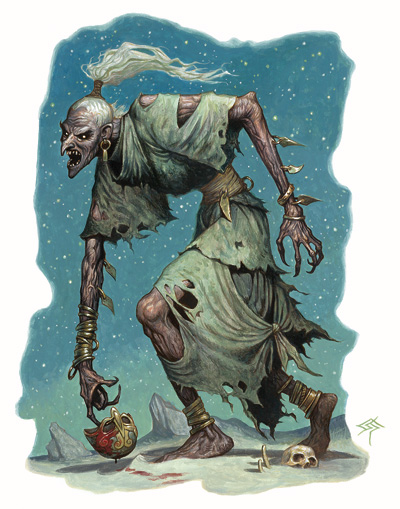 Large Monstrous Humanoid
Hit Dice: 5d8+15 (37 hp)
Initiative: +1
Speed: 40 ft (8 squares)
Armor Class: 18 (-1 size, +1 Dex, +8 natural), touch 10, flat-footed 17
Base Attack/Grapple: +5/+14
Attack: Claw +10 melee (1d6+5)
Full Attack: 2 claws +10 melee (1d6+5) and bite +5 melee (1d6+2)
Space/Reach: 10 ft./10 ft.
Special Attacks: Improved grab, enthrall, spell-like abilities
Special Qualities: Damage reduction 2/—, darkvision 60 ft., spell resistance 18
Saves: Fort +4, Ref +5, Will +5
Abilities: Str 21, Dex 13, Con 16, Int 12, Wis 12, Cha 15
Skills: Bluff +8, Climb +9, Intimidate +6, Listen +6, Spot +6, Survival +5
Feats: Alertness, Endurance
Environment: Warm deserts
Organization: Solitary or covey (2-4 dune hags plus 1-8 ogres and 1-4 evil giants)
Challenge Rating: 4
Treasure: Standard
Alignment: Always chaotic evil
Advancement: By character class
Level Adjustment: —
Large Monstrous Humanoid
Hit Dice: 5d8+15 (37 hp)
Initiative: +1
Speed: 40 ft (8 squares)
Armor Class: 18 (-1 size, +1 Dex, +8 natural), touch 10, flat-footed 17
Base Attack/Grapple: +5/+14
Attack: Claw +10 melee (1d6+5)
Full Attack: 2 claws +10 melee (1d6+5) and bite +5 melee (1d6+2)
Space/Reach: 10 ft./10 ft.
Special Attacks: Improved grab, enthrall, spell-like abilities
Special Qualities: Damage reduction 2/—, darkvision 60 ft., spell resistance 18
Saves: Fort +4, Ref +5, Will +5
Abilities: Str 21, Dex 13, Con 16, Int 12, Wis 12, Cha 15
Skills: Bluff +8, Climb +9, Intimidate +6, Listen +6, Spot +6, Survival +5
Feats: Alertness, Endurance
Environment: Warm deserts
Organization: Solitary or covey (2-4 dune hags plus 1-8 ogres and 1-4 evil giants)
Challenge Rating: 4
Treasure: Standard
Alignment: Always chaotic evil
Advancement: By character class
Level Adjustment: —
This creature looks like an extraordinarily tall but decrepit female human, dressed in filthy robes and a ragged burnoose. Her skin is a sickly greenish-brown, her hair iron-gray, and her rotting teeth brown and black.
Wasteland cousins of the annis, dune hags use their disguise self and enthrall abilities to lure victims to their deaths. Dune hags enjoy the taste of humanoid flesh, and they take great risks to procure a meal of it whenever possible.
A dune hag stands just over 8 feet tall and weighs some 350 pounds.
Dune hags speak Common and Giant.
COMBAT
Dune hags do not like engaging in direct confrontation; they prefer to lure their victims to out-of-the-way places, where they either ambush the victim with superior numbers, trick the victim into some suicidal action, or simply wait until the victim is sleeping. To this end, they employ their disguise self ability to get close to unsuspecting victims, and try to kiss the victim before drawing him or her to some secluded spot for a "tryst." If found out, a dune hag tries to kiss at least one enemy before fleeing, though she eventually returns to try to lure the enthralled victim to its death.
Improved Grab (Ex): To use this ability, a dune hag must hit a creature of any size with its claw attack. It can then attempt to start a grapple as a free action without provoking attacks of opportunity.
Enthrall (Su): A dune hag can mentally enslave any humanoid it kisses. If the target is not willing to be kissed, the dune hag must start a grapple with the target. Once kissed, the target must succeed on a DC 15 Will save to negate the effect of the enthrallment. An enthralled target sees the dune hag as a beautiful desert princess, and firmly believes that the hag form everyone else sees is the illusion. The effect is otherwise like a charm person spell, except that the target can attempt a new save whenever he sees the dune hag in her true form, or he is presented with incontrovertible evidence that she means to harm the victim.
Spell-Like Abilities:3/day—disguise self, haboob, skin of the cactus; 1/day—hallucinatory terrain. Caster level 7th.
DUNEWINDER |
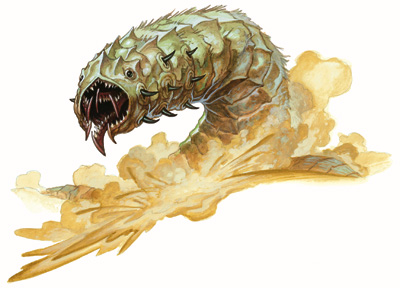 Huge Magical Beast
Hit Dice: 12d10+48 (114 hp)
Initiative: +2
Speed: 50 ft. (10 squares), burrow 20 ft.
Armor Class: 21 (-2 size, +2 Dex, +11 natural), touch 10, flat-footed 19
Base Attack/Grapple: +12/+28
Attack: Bite +18 melee (2d8+12)
Full Attack: Bite +18 melee (2d8+12)
Space/Reach: 15 ft./10 ft.
Special Attacks: Breath weapon, death throes, improved grab, poison, shred
Special Qualities: Darkvision 60 ft., immunity to dessication and fire, tremorsense 60 ft., vulnerability to cold
Saves: Fort +12, Ref + 10, Will +5
Abilities: Str 26, Dex 15, Con 19, Int 5, Wis 12, Cha 12
Skills: Hide +2, Listen +8, Spot +8, Survival +6
Feats: Alertness, Awesome Blow, Improved Bull Rush, Power Attack, Snatch
Environment: Warm deserts
Organization: Solitary
Challenge Rating: 10
Treasure: Standard
Alignment: Usually neutral
Advancement: 13-18 HD (Huge); 17-36 HD (Gargantuan)
Level Adjustment: —
Huge Magical Beast
Hit Dice: 12d10+48 (114 hp)
Initiative: +2
Speed: 50 ft. (10 squares), burrow 20 ft.
Armor Class: 21 (-2 size, +2 Dex, +11 natural), touch 10, flat-footed 19
Base Attack/Grapple: +12/+28
Attack: Bite +18 melee (2d8+12)
Full Attack: Bite +18 melee (2d8+12)
Space/Reach: 15 ft./10 ft.
Special Attacks: Breath weapon, death throes, improved grab, poison, shred
Special Qualities: Darkvision 60 ft., immunity to dessication and fire, tremorsense 60 ft., vulnerability to cold
Saves: Fort +12, Ref + 10, Will +5
Abilities: Str 26, Dex 15, Con 19, Int 5, Wis 12, Cha 12
Skills: Hide +2, Listen +8, Spot +8, Survival +6
Feats: Alertness, Awesome Blow, Improved Bull Rush, Power Attack, Snatch
Environment: Warm deserts
Organization: Solitary
Challenge Rating: 10
Treasure: Standard
Alignment: Usually neutral
Advancement: 13-18 HD (Huge); 17-36 HD (Gargantuan)
Level Adjustment: —
An enormous, bristling worm flings itself across a dune, mouth gaping. Its skin is a mottled reddish-brown.
Dunewinders are a distant cousins of the remorhaz, native to waste climates instead of arctic zones. Their most distinctive characteristic is their sidewinding motion, which allows them to traverse loose sand with amazing speed.
A dunewinder's long, mottled body can reach 40 feet in length, and it is covered with stiff, sharp bristles that drip with a green venom. The bristles let the creature get a grip in the desert's shifting surface and provide a devastating attack against any prey the dunewinder seizes.
Dunewinders cannot speak.
COMBAT
Dunewinders do not have the wide maw of other serpentine creatures, so they "tenderize" a meal before consuming it. Generally a dunewinder lies in ambush, using its natural coloration to blend in with the sand. When it attacks, it rears up suddenly to blast prey with its breath weapon. It then wraps around the victim, shredding it with its poisonous bristles.
Breath Weapon (Su): 60-ft. line, once per hour, 10d6 fire, Reflex DC 20 half. The save DC is Constitutionbased.
Death Throes (Ex): When killed, a dunewinder explodes in a blast of spiked flesh that deals 12d4 points of piercing damage to everything within 60 feet (Reflex half DC 20). The save DC is Constitution-based. In addition, all creatures injured by this attack must make Fortitude saves or be poisoned (see Poison, below).
Improved Grab (Ex): To use this ability, a dunewinder must hit with its bite attack. It can then attempt to start a grapple as a free action without provoking attacks of opportunity. If it wins the grapple check, it can shred its opponent.
Poison (Ex): Injury, Fortitude DC 20, initial and secondary damage 1d8 Con. The save DC is Constitutionbased.
Shred (Ex): On a successful grapple check, a dunewinder crushes the creature it has grabbed, dealing 3d4+12 points of piercing damage. In addition, the bristles inject poison into the wounds.
Immunity to Dessication (Ex): A dunewinder has immunity to any spell or effect that deals magical dessication damage, as well as to any damage that results from failed Constitution checks to resist the effects of dehydration. A dunewinder cannot become dehydrated (as the condition; see page 15).
Skills: Dunewinders have a +8 racial bonus on Hide checks. In a sandy environment, this bonus increases to +12.
DUSTBLIGHT |
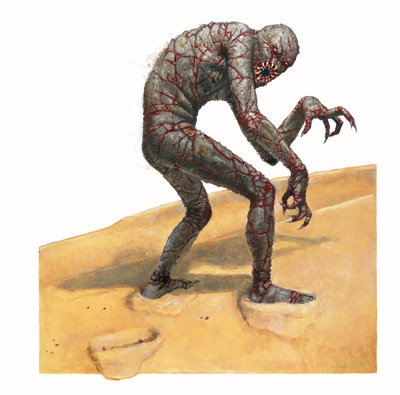 Medium Aberration
Hit Dice: 5d8+5(27 hp)
Initiative: +3
Speed: 30 ft. (6 squares), burrow 30 ft.
Armor Class: 20 (+3 Dex, +7 natural), touch 13, flatfooted 17
Base Attack/Grapple: +3/+8
Attack: Bite +8 melee (1d8+5)
Full Attack: Bite +8 melee (1d8+5) and 2 claws +6 melee (1d3+2)
Space/Reach: 5 ft./5 ft.
Special Attacks: —
Special Qualities: Low-light vision, tremorsense 60 ft.
Saves: Fort +2, Ref +6, Will +6
Abilities: Str 20, Dex 17, Con 12, Int 6, Wis 14, Cha 8
Skills: Craft (trapmaking) +2, Hide +5, Listen +3, Spot +3
Feats: Lightning Reflexes, Multiattack, Sand Dancer B
Environment: Warm deserts
Organization: Solitary, pair, or cavalry (2-4 riding ashworms)
Challenge Rating: 3
Treasure: Standard
Alignment: Usually neutral evil
Advancement: 6-7 HD (Medium); 8-15 HD (Large)
Level Adjustment: +3
Medium Aberration
Hit Dice: 5d8+5(27 hp)
Initiative: +3
Speed: 30 ft. (6 squares), burrow 30 ft.
Armor Class: 20 (+3 Dex, +7 natural), touch 13, flatfooted 17
Base Attack/Grapple: +3/+8
Attack: Bite +8 melee (1d8+5)
Full Attack: Bite +8 melee (1d8+5) and 2 claws +6 melee (1d3+2)
Space/Reach: 5 ft./5 ft.
Special Attacks: —
Special Qualities: Low-light vision, tremorsense 60 ft.
Saves: Fort +2, Ref +6, Will +6
Abilities: Str 20, Dex 17, Con 12, Int 6, Wis 14, Cha 8
Skills: Craft (trapmaking) +2, Hide +5, Listen +3, Spot +3
Feats: Lightning Reflexes, Multiattack, Sand Dancer B
Environment: Warm deserts
Organization: Solitary, pair, or cavalry (2-4 riding ashworms)
Challenge Rating: 3
Treasure: Standard
Alignment: Usually neutral evil
Advancement: 6-7 HD (Medium); 8-15 HD (Large)
Level Adjustment: +3
This revolting, stooped humanoid appears to be composed of dark gray ash, through which rivulets of blood flow like exposed veins. Its mouth gapes with terrible teeth, and its claws look eager for fresh victims.
Although not especially intelligent, dustblights are wily wasteland hunters. They can move equally well through sand and above it, and they often lie in wait beneath a thin coating of sand for those unlucky enough to be deemed prey.
Lurking in desolate wastelands, dustblights are solitary creatures concerned primarily with feeding. Like other creatures require meat, dustblights require the liquid blood that runs through the veins of their prey, which keeps them moist and limber. Where other creatures would starve without food, dustblights dry up and blow away if they don't consume enough blood.
Dustblights are very fond of ashworms and often keep them as others keep bees. Some dustblights have learned to ride ashworms.
Dustblights and asheratis are mortal enemies—asheratis hunt dustblights without hesitation or remorse. Some tales hint that dustblights were once asheratis that were transformed into awful creatures of hunger and deceit by a curse of the deep desert.
A dustblight is about 6-1/2 feet tall and weighs about 230 pounds.
Dustblights speak Asherati and sometimes Common.
COMBAT
Dustblights like to move in and rend with their claws, though they also attempt to use their Sand Dancer feat when possible.
DUSTFORM CREATURE |
The dust of the waste is not all arid dirt and tine sand. Creatures long-dead eventually become dust, and as dust they can return.
Dustform creatures appear more or less as they did in life, though in form only. Even casual observation reveals that they are composed entirely of compacted dust, like realistic but not quite finished statues.
Dustform creatures understand whatever languages they understood in life, though they can no longer speak them.
SAMPLE DUSTFORM CREATURE
This example uses a giant banded lizard as the base creature.
Dustform Giant Banded Lizard
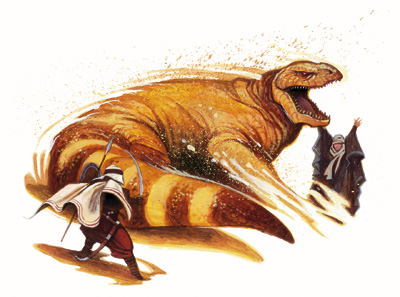 Huge Construct
Hit Dice: 10d10 (55 hp)
Initiative: -1
Speed: 20 ft. (4 squares), climb 10 ft., swim 10 ft.
Armor Class: 17 (-2 size, -1 Dex, +10 natural), touch 7, flat-footed 17
Base Attack/Grapple: +7/+26
Attack: Claw +16 melee (2d6+11) or slam +16 melee (2d6+11)
Full Attack: 2 claws +16 melee (2d6+11) or 2 slams +16 melee (2d6+11), and bite +11 melee (2d8+6)
Space/Reach: 15 ft./10 ft.
Special Attacks: Breath weapon
Special Qualities: Blindsight, construct traits, damage reduction 5/magic, low-light vision, scent
Saves: Fort +10, Ref +4, Will +5
Abilities: Str 32, Dex 8, Con —, Int —, Wis 10, Cha 5
Skills: Climb +14, Hide -1 , Listen +7, Spot +4
Feats: Alertness, Cleave, Improved Overrun, Power Attack
Environment: Warm deserts and evaporated seas
Organization: Solitary
Challenge Rating: 9
Alignment: Always neutral
Advancement: 11-14 HD (Huge); 15-30 HD (Gargantuan)
Level Adjustment: —
Huge Construct
Hit Dice: 10d10 (55 hp)
Initiative: -1
Speed: 20 ft. (4 squares), climb 10 ft., swim 10 ft.
Armor Class: 17 (-2 size, -1 Dex, +10 natural), touch 7, flat-footed 17
Base Attack/Grapple: +7/+26
Attack: Claw +16 melee (2d6+11) or slam +16 melee (2d6+11)
Full Attack: 2 claws +16 melee (2d6+11) or 2 slams +16 melee (2d6+11), and bite +11 melee (2d8+6)
Space/Reach: 15 ft./10 ft.
Special Attacks: Breath weapon
Special Qualities: Blindsight, construct traits, damage reduction 5/magic, low-light vision, scent
Saves: Fort +10, Ref +4, Will +5
Abilities: Str 32, Dex 8, Con —, Int —, Wis 10, Cha 5
Skills: Climb +14, Hide -1 , Listen +7, Spot +4
Feats: Alertness, Cleave, Improved Overrun, Power Attack
Environment: Warm deserts and evaporated seas
Organization: Solitary
Challenge Rating: 9
Alignment: Always neutral
Advancement: 11-14 HD (Huge); 15-30 HD (Gargantuan)
Level Adjustment: —
This massive reptile has powerful jaws, sharp claws, and a thick, heavy tail. While it appears as though faint hands of color might mark the lizard's skin, the shading is occluded by the shifting dust of which the creature seems composed.
Combat
A dustform giant banded lizard is an aggressive and deadly foe. Its already potent combat abilities have been enhanced with a devastating breath weapon and construct immunities.
Breath Weapon (Su): 10-foot cone, once every 2d4 rounds, damage 5d6 from dust and grit, Reflex DC 13 half. The save DC is Charisma-based. Skills: The dustform giant banded lizard has a +8 racial bonus on Hide checks in sandy environments.
CREATING A DUSTFORM CREATURE
"Dustform" is an acquired template that can be added to any living creature (referred to hereafter as the base creature).
A dustform creature uses all the base creature's statistics and special abilities except as noted here.
Size and Type:The creature's type changes to construct. Do not recalculate base attack bonus, saves, or skill points. Size is unchanged.
Hit Dice: Change all current and future Hit Dice to d10s.
Armor Class: The base creature's natural armor bonus increases by 5.
Attack: A dustform creature retains all the attacks of the base creature and gains a slam attack if it didn't already have one. If the base creature can use weapons, the dustform creature retains this ability. A creature with natural weapons retains those natural weapons. A dustform creature fighting without weapons uses either its slam attack or its primary natural weapon (if it has any). A dustform creature armed with a weapon uses its slam or a weapon, as it desires.
Full Attack: A dustform creature fighting without weapons uses either its slam attack (see above) or its natural weapons (if it has any). If armed with a weapon, it usually uses the weapon as its primary attack along with a slam or other natural weapon as a natural secondary attack.
Damage:Dustform creatures have slam attacks. If the base creature does not have this attack form, use the appropriate damage value from the table below according to the dustform creature's size. Creatures that have other kinds of natural weapons retain their old damage values or use the appropriate value from the table below, whichever is better.
| Size | Damage |
|---|---|
| Fine | 1 |
| Diminutive | 1d2 |
| Tiny | 1d3 |
| Small | 1d4 |
| Medium | 1d6 |
| Large | 1d8 |
| Huge | 2d6 |
| Gargantuan | 2d8 |
| Colossal | 4d6 |
Special Attacks: A dustform creature loses all the special attacks of the base creature, but gains those described below. Saves have a DC of 10 + 1/2 dustform creature's HD + dustform creature's Cha modifier unless noted otherwise.
Breath Weapon (Su): As a standard action every 2d4 rounds, a dustform creature can spew out a 10foot cone of dust and sand. The cone deals 1d6 points of damage for each 2 Hit Dice the creature possesses, and creatures within the area can make Reflex saves for half damage. The save DC is Charisma-based. If the base creature already has a breath weapon, that breath weapon changes to sand, with a Charisma-based saving throw DC. Otherwise, all details remain the same. For example, a dustform juvenile blue dragon could spew forth a line of sand (rather than lightning) once every 1d4 rounds, dealing 8d8 points of damage, with a Reflex save DC of 19.
Special Qualities: A dustform creature retains all the special qualities of the base creature and gains the following abilities:
Blindsight (Ex): Dustform creatures are blind, but they can sense all creatures within 60 feet as a sighted creature would by defecting subtle vibrations in the air around them. Beyond that range, they treat all targets as having total concealment.
Construct Traits: Constructs have immunity to poison, sleep, paralysis, stunning, and mind-affecting spells and abilities. They are not subject to extra damage from critical hits or flanking. In addition, a dustform creature cannot be polymorphed into a nondustform creature.
Damage Reduction (Su): Dustform creatures have damage reduction 5/magic. A dustform creature's own natural weapons are treated as magic weapons for the purpose of overcoming damage reduction.
Abilities: Adjust the base creatures abilities as follows: Str +4, Dex -2 . As a construct, a dustform creature has no Constitution or Intelligence score.
Skills: Dustform creatures have a +8 racial bonus on Hide checks made in a sandy or dusty environment. Otherwise same as the base creature.
Environment: Dustform creatures are found exclusively in deserts and wastelands.
Challenge Rating: Same as the base creature +2.
Treasure: None.
Alignment: Always neutral.
Advancement: None.
Level Adjustment: Same as the base creature +2.
Dustform Creature Weaknesses
Dustform creatures have one fatal weakness. A critical hit with a bludgeoning weapon forces the dustform creature to make a Will save to remain cohesive; otherwise it dissolves into lifeless dust again. The DC for the Will save is equal to 10 + damage dealt.
DUST TWISTER |
A slender twister races across the desert, like a waterspout of sand and dust, though it moves with purpose.
A dust twister sometimes results from the union of an air elemental and a jann. While extraplanar in nature, most are consigned to the Material Plane, and they favor forlorn deserts and hidden oases where they can bedevil any janni they find.
A dust twister usually appears as a slender cylinder of wind and sand that can reach a height of 20 feel. When carrying a "rider" or a load, the load appears at the base of the twister 5 feet above the ground, visible within the 5-foot-diameter swirling core but apparently untouched by the scouring winds.
Carrying Capacity: A dust twister is treated as a large quadruped, and benefits from its strength of the whirlwind ability, when determining its carrying capacity. A light load for a dust twister is up to 460 pounds; a medium load, up to 900 pounds; and a heavy load, up to 1,300 pounds. A dust twister cannot drag an item.
COMBAT
A dust twister uses a portion of its whirling form to blast foes with its slam attack. Strength of the Whirlwind
(Ex): A dust twister uses its Dexterity score to determine its carrying capacity. A creature or object can be caught up in the body of a dust twister if it touches or enters the whirlwind, or it the dust twister moves through the creature's or object's space. An affected creature that does not wish to be carried along by the dust twister must succeed on a Reflex save when it comes into contact with the whirlwind or be picked up and held safely suspended in the calm eye of the twister. A creatures held within the eye of the dust twister can take a move action to extricate itself, if a dust twister wishes, it can expel its passenger in a precipitous manner, dealing 1d6 points of damage to the passenger or cargo as it is dropped upon the ground.
FORLORN HUSK |
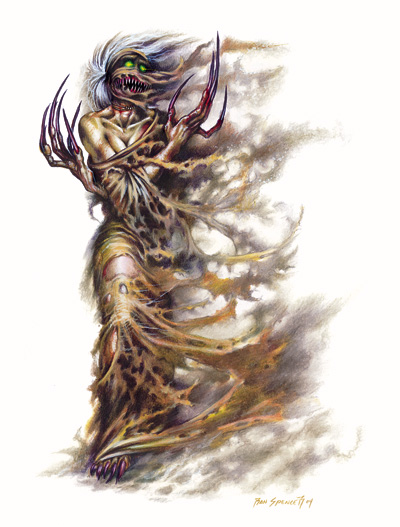 Medium Undead
Hit Dice: 3d12 (19 hp)
Initiative: +3
Speed: 30 ft. (6 squares)
Armor Class: 17 (+3 Dex, +4 natural), touch 13, flatfooted 14
Base Attack/Grapple: +1/+5
Attack: Claw +5 melee (1d6+4)
Full Attack: 2 claws +5 melee (1d6+4) and bite +3 melee (1d4+2)
Space/Reach: 5 ft./5 ft.
Special Attacks: Create spawn, improved grab, water drain
Special Qualities: Damage reduction 5/magic, drawn to water, darkvision 60 ft., fast healing 2, lowlight vision, spider climb, undead traits
Saves: Fort +1, Ref +4, Will +4
Abilities: Str 18, Dex 17, Con —, Int 11, Wis 13, Cha 10
Skills: Hide +6, Listen +6, Move Silently +6, Spot +6
Feats: Alertness, Multiattack
Environment: Warm deserts
Organization: Solitary or pair
Challenge Rating: 4
Treasure: Standard
Alignment: Always neutral
Advancement: By character class
Level Adjustment: —
Medium Undead
Hit Dice: 3d12 (19 hp)
Initiative: +3
Speed: 30 ft. (6 squares)
Armor Class: 17 (+3 Dex, +4 natural), touch 13, flatfooted 14
Base Attack/Grapple: +1/+5
Attack: Claw +5 melee (1d6+4)
Full Attack: 2 claws +5 melee (1d6+4) and bite +3 melee (1d4+2)
Space/Reach: 5 ft./5 ft.
Special Attacks: Create spawn, improved grab, water drain
Special Qualities: Damage reduction 5/magic, drawn to water, darkvision 60 ft., fast healing 2, lowlight vision, spider climb, undead traits
Saves: Fort +1, Ref +4, Will +4
Abilities: Str 18, Dex 17, Con —, Int 11, Wis 13, Cha 10
Skills: Hide +6, Listen +6, Move Silently +6, Spot +6
Feats: Alertness, Multiattack
Environment: Warm deserts
Organization: Solitary or pair
Challenge Rating: 4
Treasure: Standard
Alignment: Always neutral
Advancement: By character class
Level Adjustment: —
Ragged, withered, and yammering with lunatic glee, this humanoid creature has eyes that seem to give off a green glow. Its smile is jogged with overlarge and pointed slobs of grinding bone, while its hands are heavy with yellowed, foul claws.
A forlorn husk sometimes results when a humanoid dies of thirst in the desert. Wild and savage, it roams the sands seeking the moisture it was denied in life. Equipped with sharp teeth and claws, a forlorn husk slaughters the living to drink the body fluids that quench its unholy thirst.
A forlorn husk appears mostly the same as it did in life, except that its skin takes on a parchment like quality, its teeth and fingernails develop wicked points, and its eyes gleam with a pale green luminescence.
A forlorn husk speaks Common, as well as any languages it spoke when alive.
COMBAT
A forlorn husk is virtually fearless in its quest for moisture, sneaking into camps and houses to attack sleeping victims, then creeping out again just as quietly, leaving behind desiccated corpses. After dealing claw or bite damage, a forlorn husk attempts to grapple its victim, sucking the creature's body fluids out through the open wound. A forlorn husk can sometimes be tricked away from a victim by presenting it with water, as described in the drawn to water ability, below.
Create Spawn (Su): A humanoid or monstrous humanoid slain by the dessication damage caused by a forlorn husk's water drain attack rises as a forlorn husk 1d2 days later.
Drawn to Water (Ex): If presented with a source of visible water, a forlorn husk must attempt a DC 15 Will save; if it fails, it relinquishes its grip on any victim it might have and goes after the water instead (possibly attempting to disarm the creature holding it). The forlorn husk then spends its next turn drinking the water as a full-round action. A forlorn husk can even be tricked into drinking holy water in this fashion, though it is allowed a DC 15 Wisdom check to see if it notices that it is about to drink something that can harm it. A forlorn husk that is attacked before it can drink the water immediately turns to that foe and resumes its attacks. Only if left unassaulted during this turn does it consume the water it seizes.
Improved Grab (Ex): To use this ability, a forlorn husk must hit a creature with a claw attack. It can then attempt to start a grapple as a free action without provoking attacks of opportunity. If it wins the grapple check, it gets a hold and can drain water from the victim.
Spider Climb (Su): A forlorn husk can climb sheer surfaces as though under the effect of a spider climb spell.
Water Drain (Ex): If a living target has an open wound, a forlorn husk can drain moisture from the victim by making a successful grapple check. Each such attack deals 2d6 points of dessication damage to the victim. On each such successful attack, the forlorn husk gains 5 temporary hit points that last for up to 1 hour.
GIANT BANDED LIZARD |
This giant lizard has a thick, heavy tail. Its sharp claws ore outmatched only by in powerful jaws.
Resembling some kind of dinosaur, the giant banded lizard prowls the deserts and scrublands, constantly in search of prey. Virtually fearless, it attacks any creature that crosses its lumbering path.
Up to 30 feet long, and weighing close to eight tons, a giant banded lizard moves slowly. Its long, forked tongue flickers constantly in search of prey. Its hide is covered in tubercles, or beads, usually colored orange, but sometimes found in pink, yellow, or white. A giant banded lizard's black head is streaked with orange.
COMBAT
A giant banded lizard attacks any creature its own size or smaller without hesitation. As it holds a creature fast in its mouth, a giant banded lizard pumps the creature full of venom secreted from its lower jaw.
Improved Grab (Ex): To use this ability, a giant banded lizard must hit a creature of any size with its bite attack. It can then attempt to start a grapple as a free action without provoking attacks of opportunity, if it wins the grapple check, it establishes a hold and attempts to deal bite damage each round thereafter.
Poison (Ex): Injury, Fortitude DC 21, initial and secondary damage 2d4 Str. The save DC is Constitution-based.
HALF-JANNI |
Half-jann are most prevalent in human societies that make their homes in the deserts, although some desertdwelling elf tribes have bred with the jann as well. Dwarven half-jann are considerably more rare, except where deserts give way to the kinds of mountainous terrains that dwarves favor. Certain halfling and gnome clans—those given to the nomadic lifestyle favored by the jann—have produced half-jann, while orc–jann crossbreeds are virtually unheard of.
Half-jann typically have warm-hued skin with a hint of red or gold.
SAMPLE HALF-JANNI
This elegant lady has raven tresses and warm brown skin, and she is dressed in light armor and brandishes twin scimitars. She wears jingling baubles of gold and silver and has an otherworldly quality about her. This example uses a 5th-level human fighter as the base creature.
Half-Janni 5th-Level Human Fighter
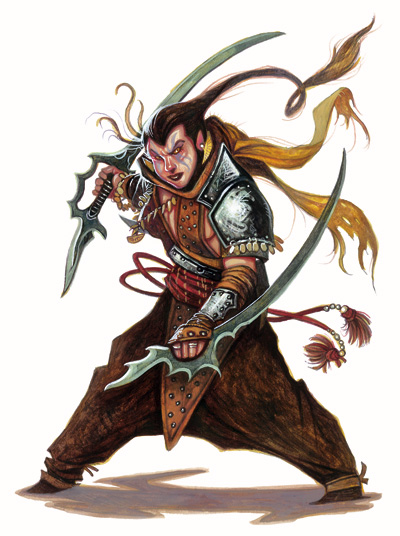 Medium Humanoid
Hit Dice: 5d10+10 (42 hp)
Initiative: +7
Speed: 30 ft. (6 squares)
Armor Class: 20 (+2 mithral chain shirt, +3 Dex, +1 natural), touch 13, flat-footed 17
Base Attack/Grapple: +5/+8
Attack: +1 scimitar +10 melee (1d6+6/ 18–20) or masterwork shortbow +9 ranged (1d6/×3)
Full Attack: +1 scimitar +6 melee (1d6+6/18–20) and +1 scimitar +6 melee (1d6+4/18–20) or masterwork shortbow +9 ranged (1d6/×3)
Space/Reach: 5 ft./5 ft.
Special Attacks: Spell-like abilities
Special Qualities: Planar jaunt, resistance to fire 5
Saves: Fort +6, Ref +4, Will +1
Abilities: Str 17, Dex 16, Con 14, Int 12, Wis 10, Cha 12
Skills: Climb +11, Intimidate +9, Ride +11
Feats: Improved InitiativeB, Mounted Combat B, Ride-By AttackB, Two-Weapon Defense, Two-Weapon Fighting, Weapon Focus (scimitar), Weapon Specialization (scimitar) B
Environment: Warm deserts and mountains
Organization: Solitary
Challenge Rating: 6
Treasure: Standard
Alignment: Usually neutral
Advancement: By character class
Level Adjustment: +3
Medium Humanoid
Hit Dice: 5d10+10 (42 hp)
Initiative: +7
Speed: 30 ft. (6 squares)
Armor Class: 20 (+2 mithral chain shirt, +3 Dex, +1 natural), touch 13, flat-footed 17
Base Attack/Grapple: +5/+8
Attack: +1 scimitar +10 melee (1d6+6/ 18–20) or masterwork shortbow +9 ranged (1d6/×3)
Full Attack: +1 scimitar +6 melee (1d6+6/18–20) and +1 scimitar +6 melee (1d6+4/18–20) or masterwork shortbow +9 ranged (1d6/×3)
Space/Reach: 5 ft./5 ft.
Special Attacks: Spell-like abilities
Special Qualities: Planar jaunt, resistance to fire 5
Saves: Fort +6, Ref +4, Will +1
Abilities: Str 17, Dex 16, Con 14, Int 12, Wis 10, Cha 12
Skills: Climb +11, Intimidate +9, Ride +11
Feats: Improved InitiativeB, Mounted Combat B, Ride-By AttackB, Two-Weapon Defense, Two-Weapon Fighting, Weapon Focus (scimitar), Weapon Specialization (scimitar) B
Environment: Warm deserts and mountains
Organization: Solitary
Challenge Rating: 6
Treasure: Standard
Alignment: Usually neutral
Advancement: By character class
Level Adjustment: +3
COMBAT
This half-janni whirls into combat, leading with her scimitars. She has the skill to fight from the back of a mount, and she might be encountered atop a war camel (see page 193).
This half-janni’s caster level for her spell-like abilities is 5th, and her planar jaunt can last for up to 5 minutes.
CREATING A HALF-JANNI
“Half-janni” is an inherited template that can be added to any humanoid creature (hereafter referred to as the base creature).
A half-janni uses all the base creature’s statistics and special abilities except as noted here.
Armor Class: The base creature’s natural armor improves by 1.
Special Attacks: A half-janni retains all the special attacks of the base creature and also gains the following special attacks.
Spell-Like Abilities:1/day— enlarge person, invisibility, reduce person, speak with animals. Caster level equals the half-janni’s HD.
Special Qualities: A half-janni retains all the special qualities of the base creature and also gains the following special qualities.
Planar Jaunt (Sp): Once per day, a half-janni can travel to any elemental plane, the Astral Plane, or the Material Plane as though using plane shift cast by a 13th-level caster. The half-janni and any willing creatures brought along appear at a random location on the destination plane. The half-janni and the creatures brought on the planar jaunt remain on the other plane (or any location on any plane they travel to from there) for a number of minutes equal to the half-janni’s number of Hit Dice. When this duration expires, the half-janni and all creatures on the planar jaunt return to their original positions on their origin plane. An effect that suppresses or dispels planar jaunt sends the half-janni and creatures brought along back to the exact places from which they left. If the space from which the half-janni originated (or a creature that accompanied her on the planar jaunt) is occupied upon its return, the half-janni (or its companions) appears in the nearest unoccupied space.
Resistance to Fire (Ex): Half-jann have resistance to fire 5.
Abilities: Change from the base creature as follows: Str +2, Dex +2, Int +2, Wis +2.
Feats: Half-jann gain Improved Initiative as a bonus feat.
Challenge Rating: Same as the base creature +1.
Level Adjustment: Same as the base creature +3.
IRONTHORN |
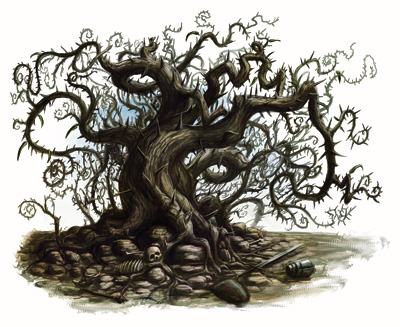 Large PlantLarge Plant
Hit Dice: 9d8+63 (103 hp)
Initiative: +0
Speed: 10 ft. (2 squares)
Armor Class: 24 (–1 size, +15 natural), touch 9, flatfooted 24
Base Attack/Grapple: +6/+13
Attack: Vine rake +8 melee (1d6+3)
Full Attack: 2 vine rakes +8 melee (1d6+3)
Space/Reach: 10 ft./5 ft. (15 feet with vines)
Special Attacks: Impale, improved grab, poison
Special Qualities: Blindsense 60 ft., damage reduction 5/bludgeoning or slashing, plant traits
Saves: Fort +13, Ref +3, Will +4
Abilities: Str 17, Dex 10, Con 25, Int 1, Wis 12, Cha 1
Skills: Spot +13
Feats: Ability Focus (poison), Heat Endurance, Improved Heat Endurance, Toughness
Environment: Warm deserts
Organization: Solitary
Challenge Rating: 6
Treasure: 1/10th coins; 50% goods; 50% items
Alignment: Always neutral
Advancement: 10–18 HD (Large); 19–27 HD (Huge)
Level Adjustment: —
Large PlantLarge Plant
Hit Dice: 9d8+63 (103 hp)
Initiative: +0
Speed: 10 ft. (2 squares)
Armor Class: 24 (–1 size, +15 natural), touch 9, flatfooted 24
Base Attack/Grapple: +6/+13
Attack: Vine rake +8 melee (1d6+3)
Full Attack: 2 vine rakes +8 melee (1d6+3)
Space/Reach: 10 ft./5 ft. (15 feet with vines)
Special Attacks: Impale, improved grab, poison
Special Qualities: Blindsense 60 ft., damage reduction 5/bludgeoning or slashing, plant traits
Saves: Fort +13, Ref +3, Will +4
Abilities: Str 17, Dex 10, Con 25, Int 1, Wis 12, Cha 1
Skills: Spot +13
Feats: Ability Focus (poison), Heat Endurance, Improved Heat Endurance, Toughness
Environment: Warm deserts
Organization: Solitary
Challenge Rating: 6
Treasure: 1/10th coins; 50% goods; 50% items
Alignment: Always neutral
Advancement: 10–18 HD (Large); 19–27 HD (Huge)
Level Adjustment: —
This twisted shrub has only a few waxy leaves and is covered with wicked, foot-long thorns. Bones and rusted armor protrude from its gnarled limbs.
The ironthorn is a tough, waste-adapted plant that snatches passing creatures and impales them on its thorns to gain nourishment. Typical ironthorns are about the size of apple trees, about 15 feet tall, with thick bark and a few needlelike leaves.
Ironthorn sap is prized as a natural hardening agent, used in making armor and other items. However, the plants are dangerous predators and resistant to damage, making collecting of the sap a tricky proposition.
An ironthorn is barely sentient and generally does not move once it has found a suitable rooting spot. Ironthorns do not speak or understand any language.
Combat
An ironthorn waits for a creature to pass within reach of its feeding vines, which look like its other twisted branches until they lash out. With their extended reach, the vines often take prey by surprise.
Once it has grabbed its prey, an iron thorn pulls it deep into its mass of poisonous thorns, where the victim is impaled and left to slowly die. The ironthorn then slowly absorbs the flesh as it rots.
Impale (Ex): An ironthorn deals 2d6+4 points of damage to a grabbed opponent with a successful grapple check. The opponent is pulled deep into the plant’s thorny mass and is subject to the plant’s poison (see below).
Improved Grab (Ex): To use this ability, an ironthorn must hit with a vine attack. It can then attempt to start a grapple as a free action without provoking attacks of opportunity. If it wins the grapple check, it establishes a hold and can impale.
Poison (Ex): Injury, Fortitude DC 23, initial damage paralysis 1d4 minutes, secondary damage 2d4 Con. A victim must save against the secondary damage each minute that it is held in the thorns. The save DC is Constitution-based.